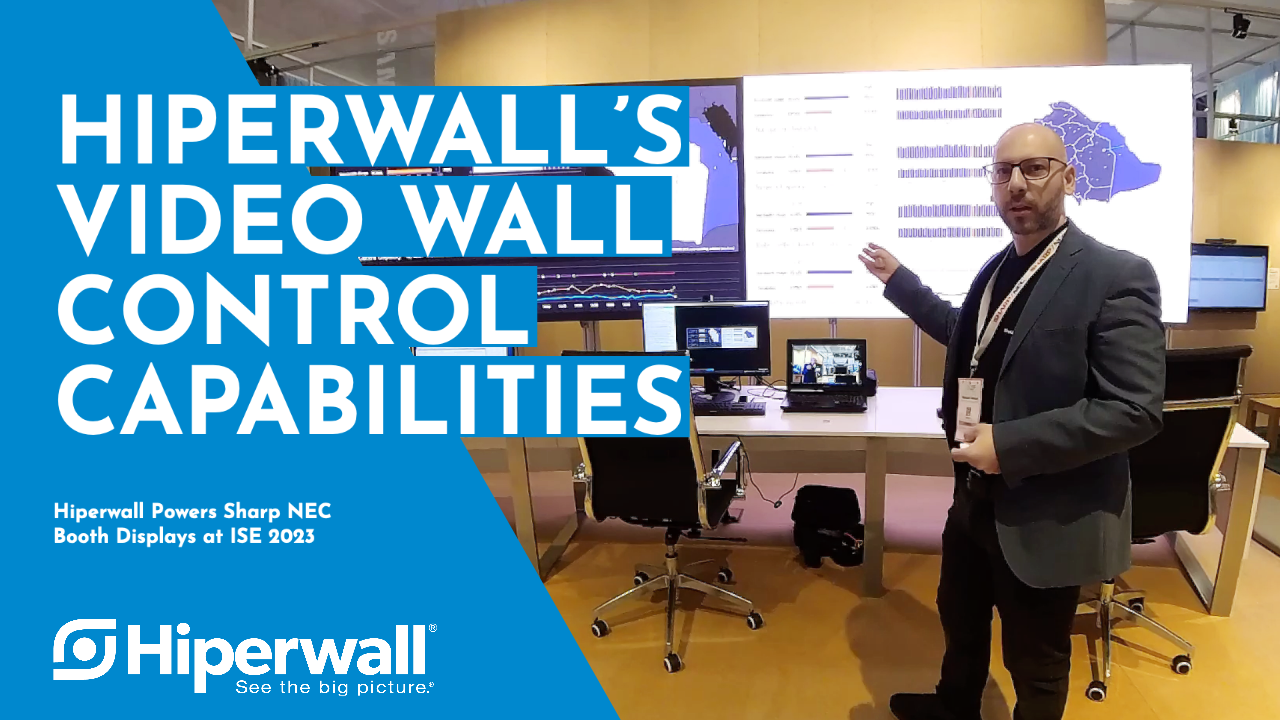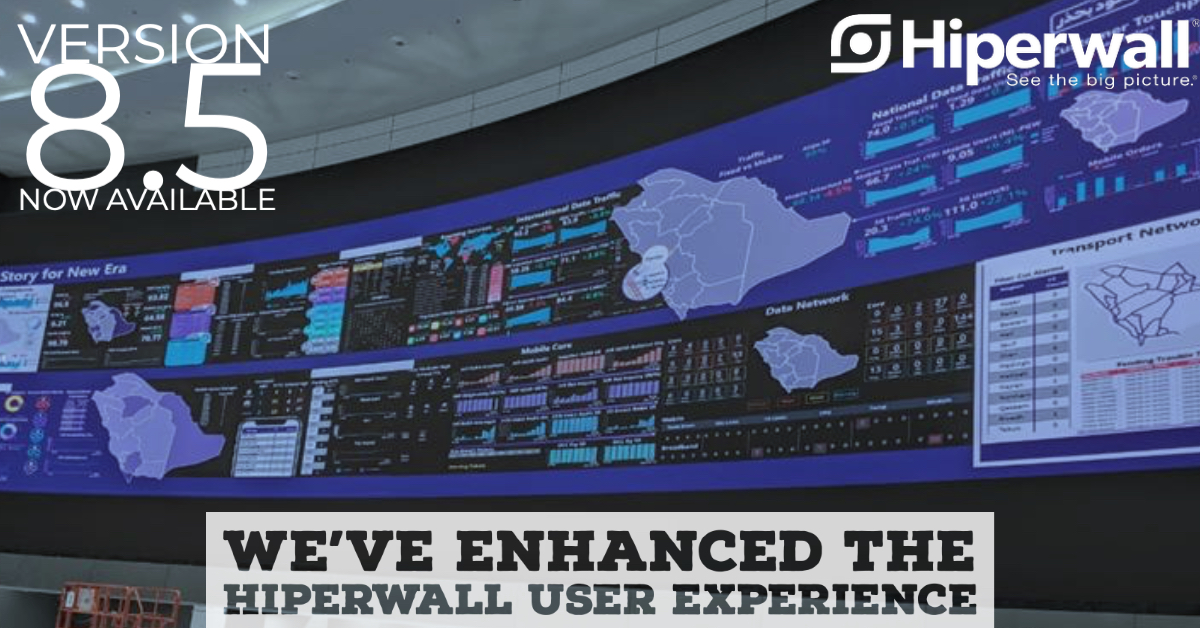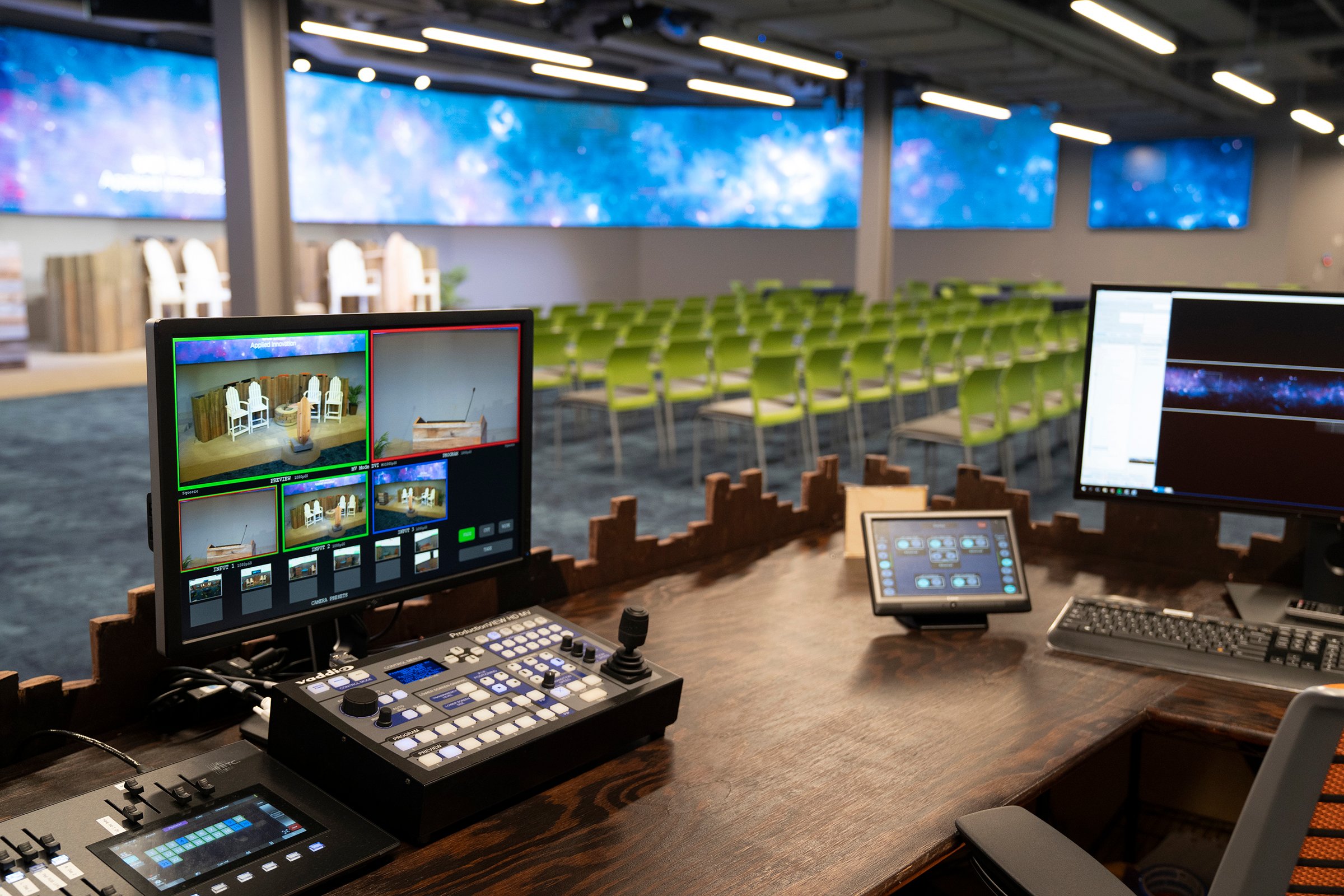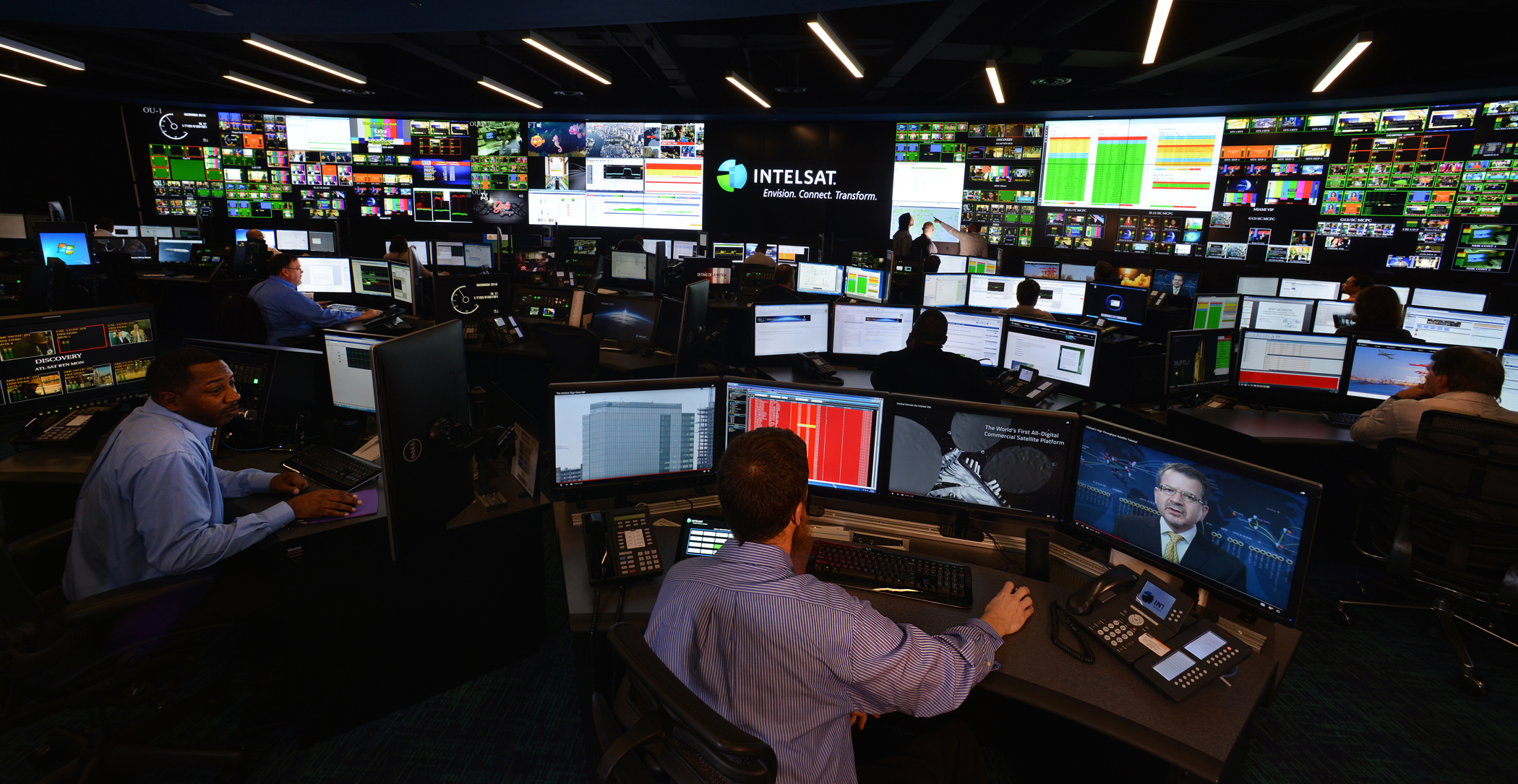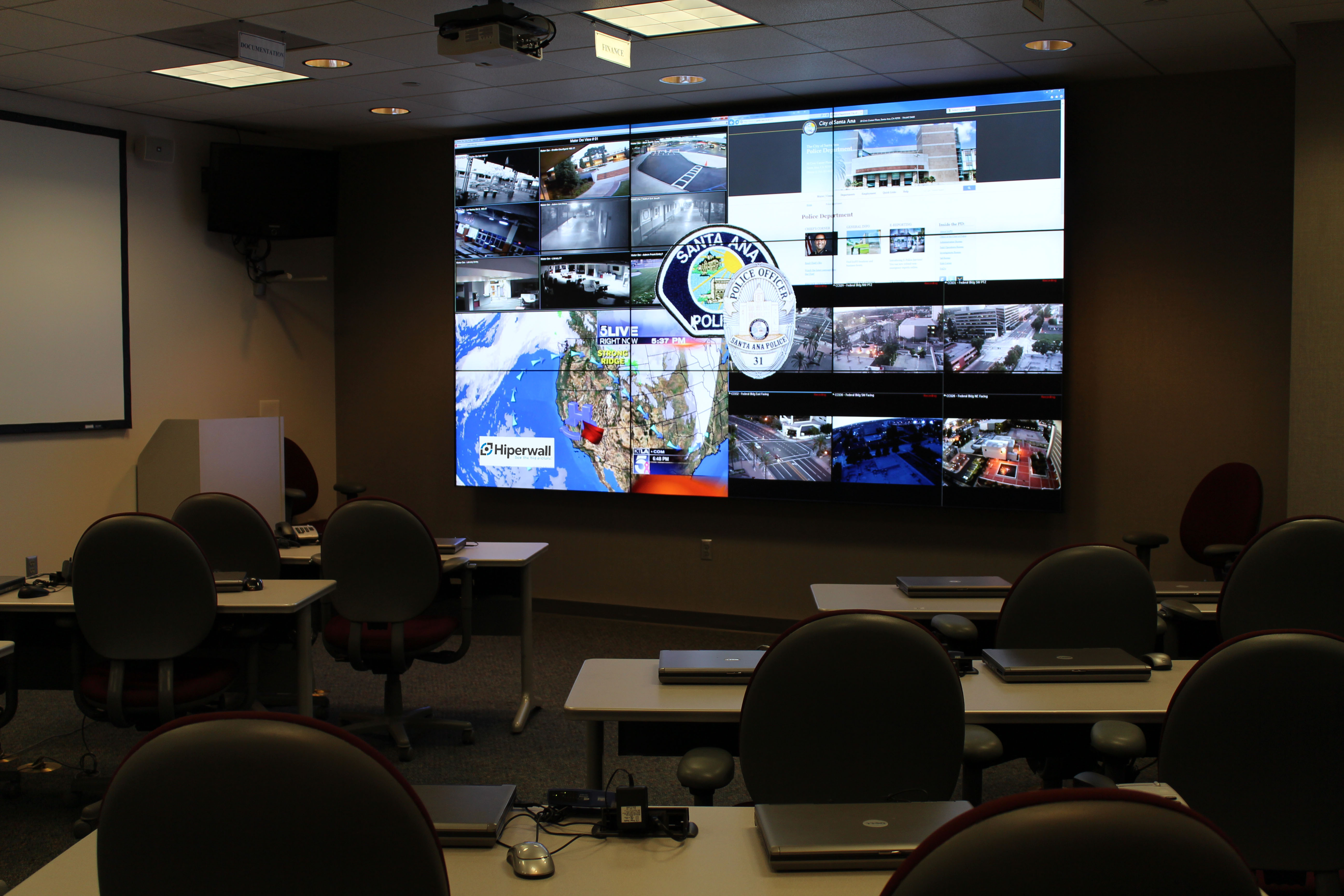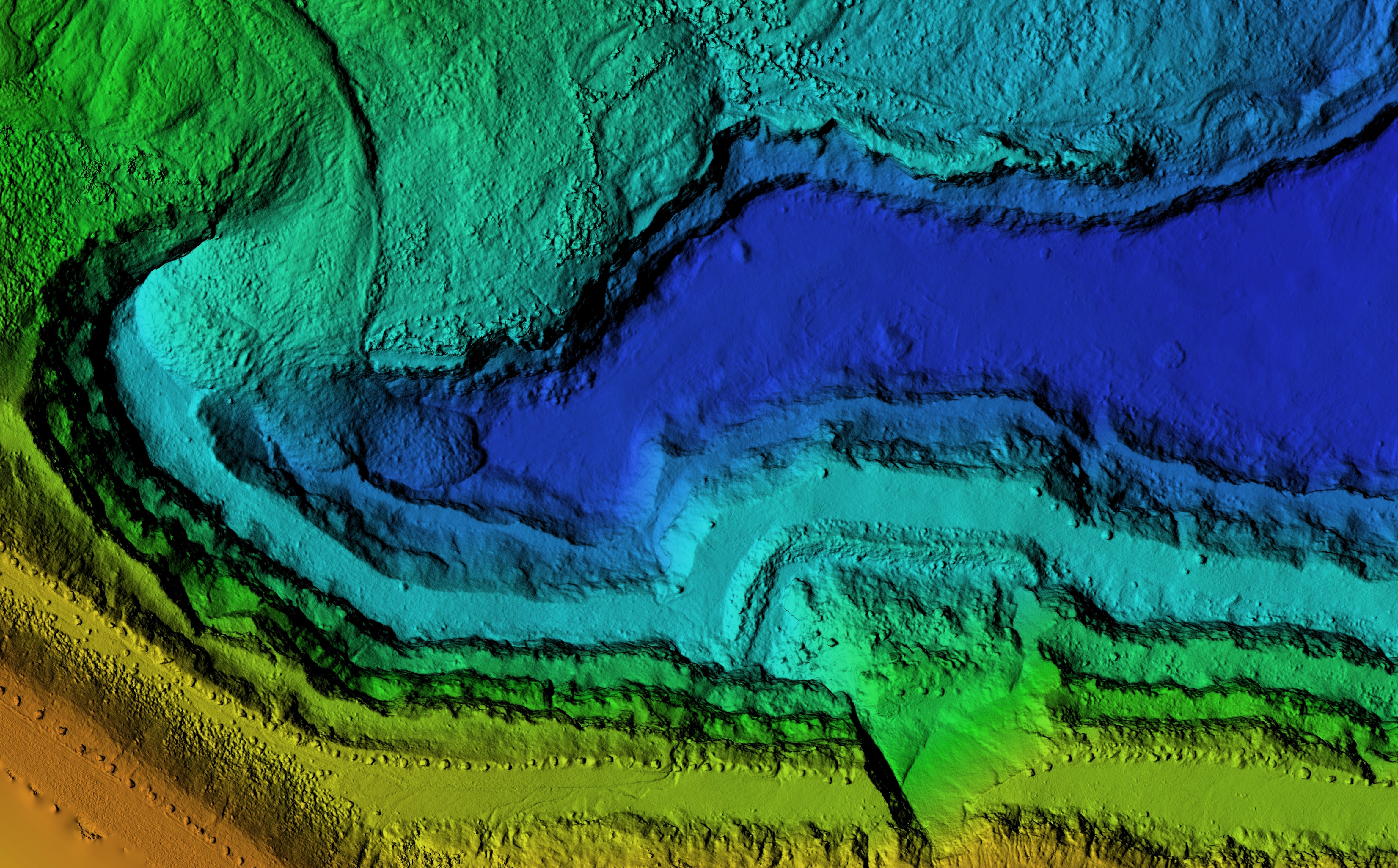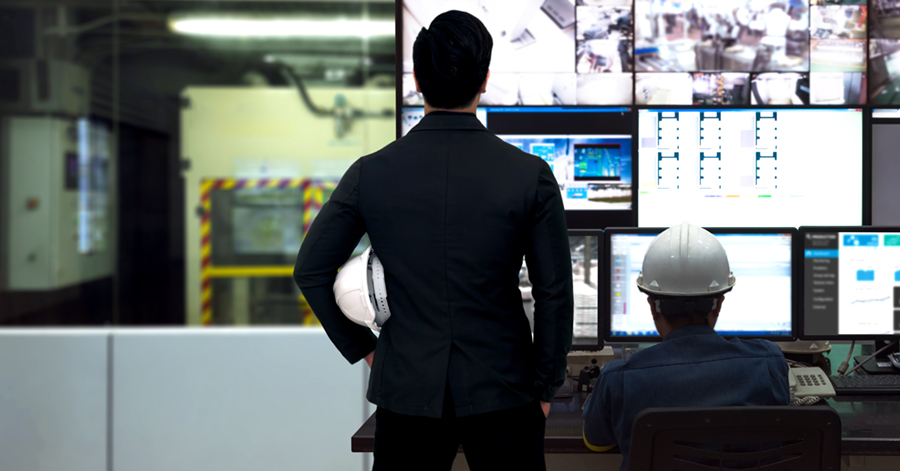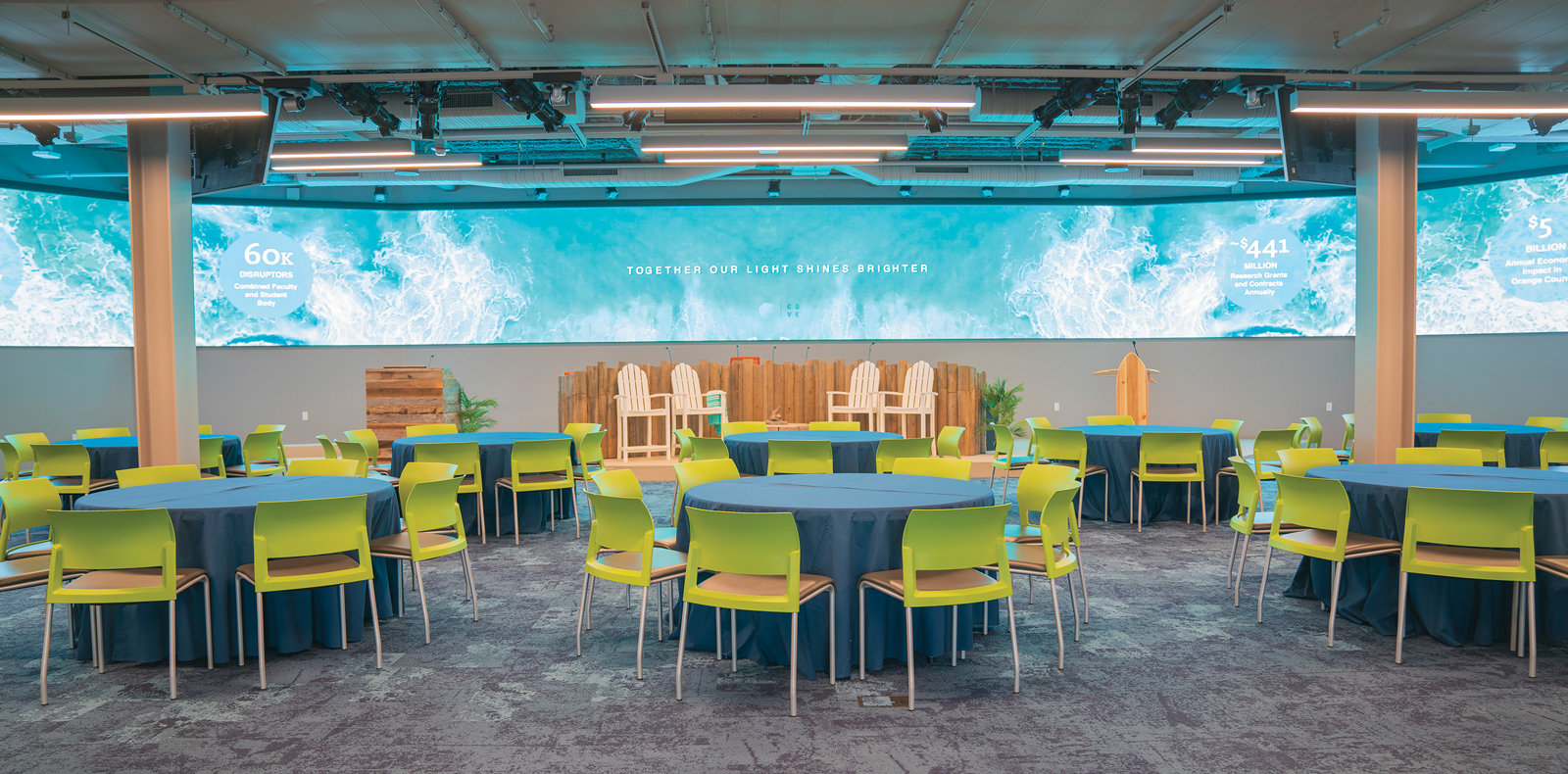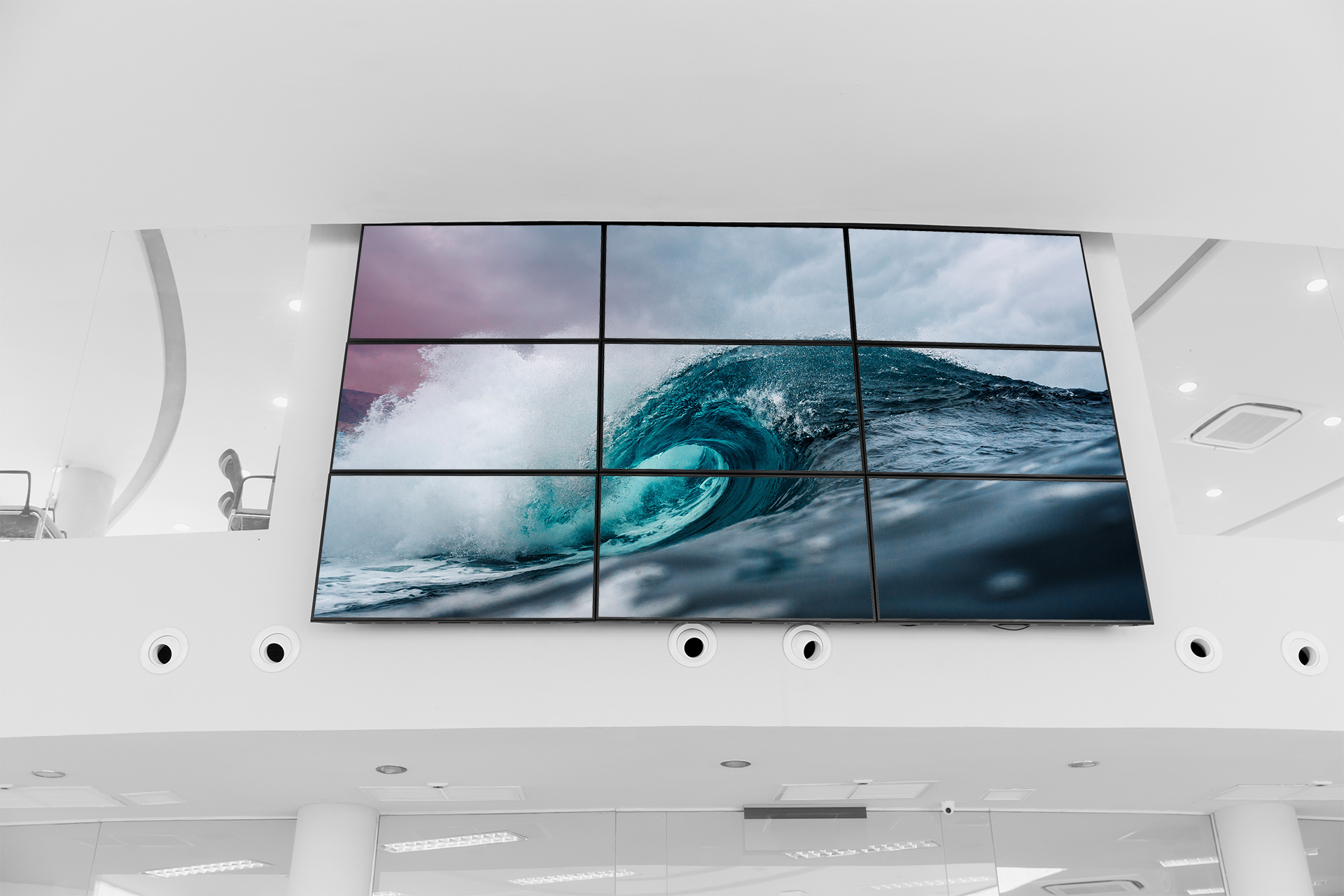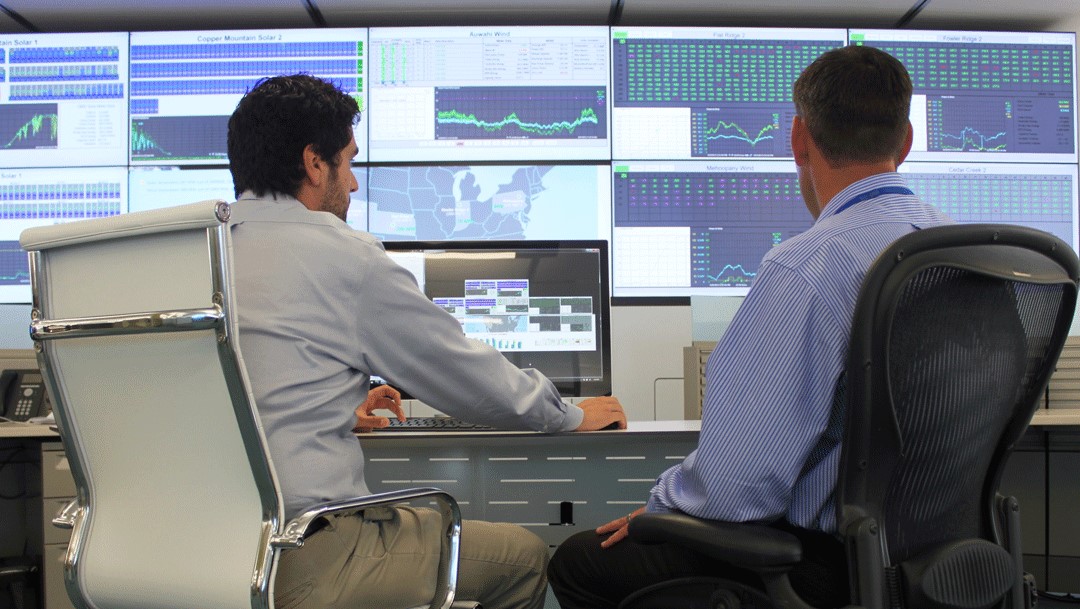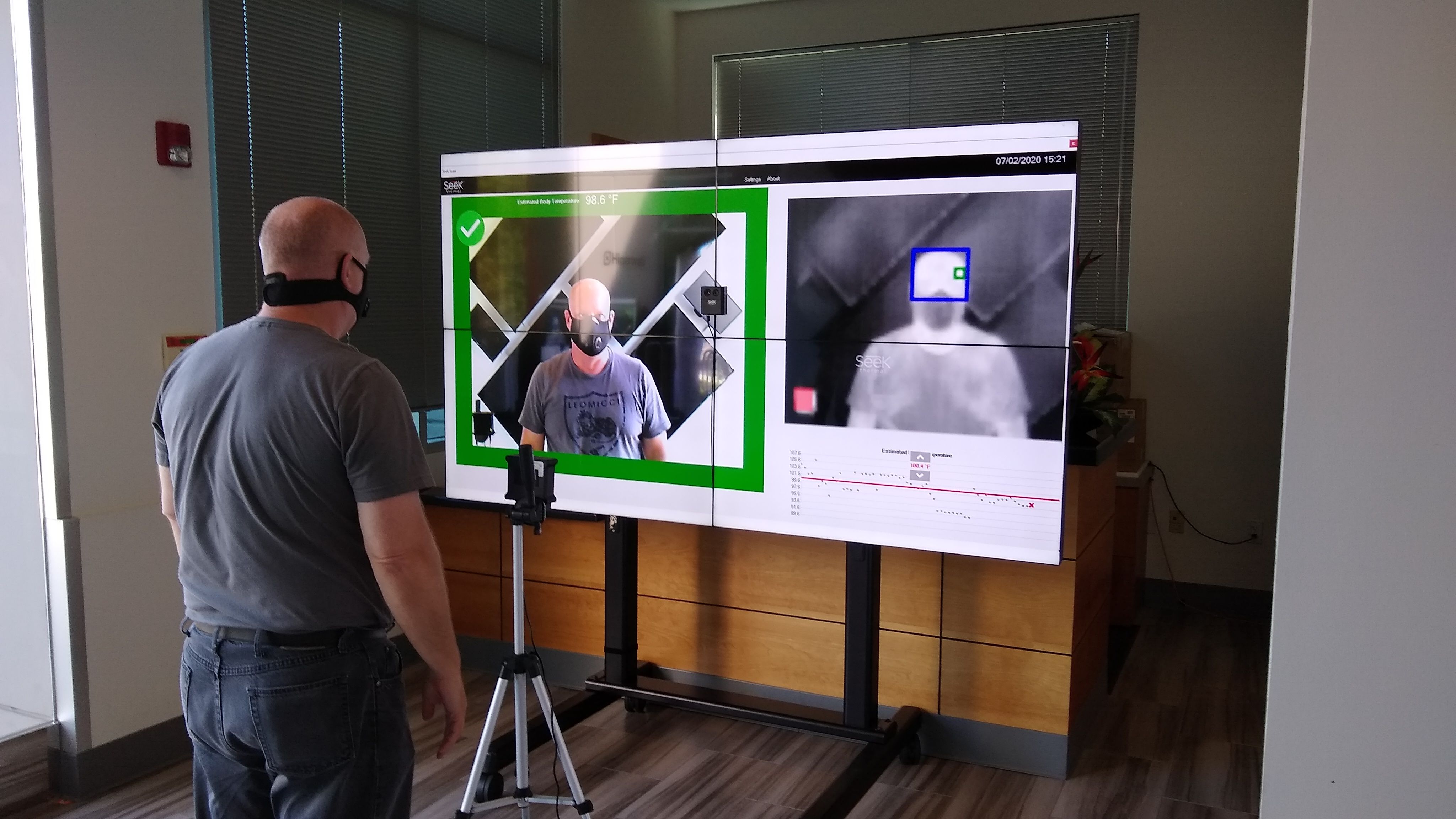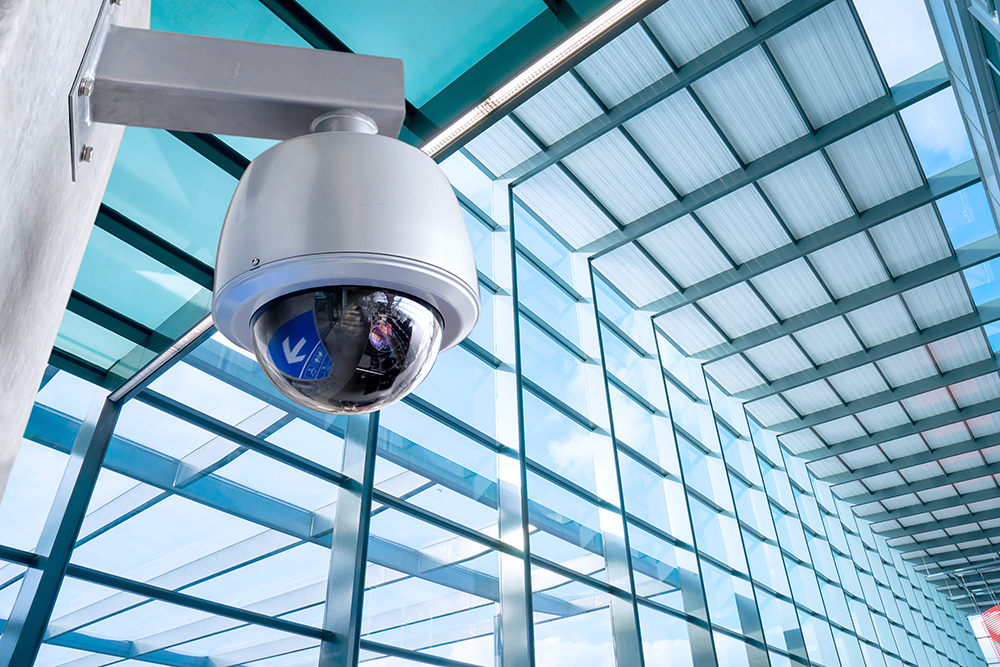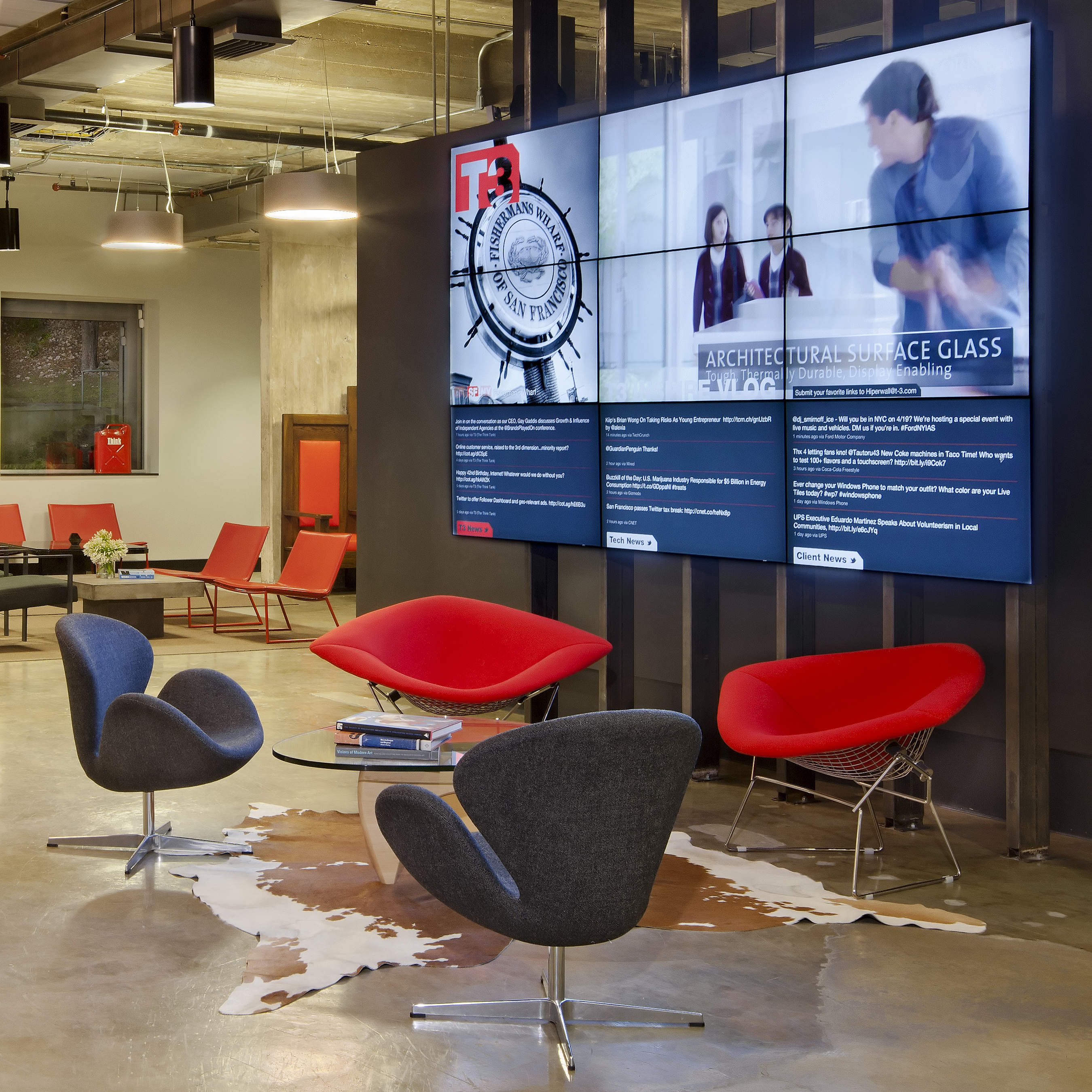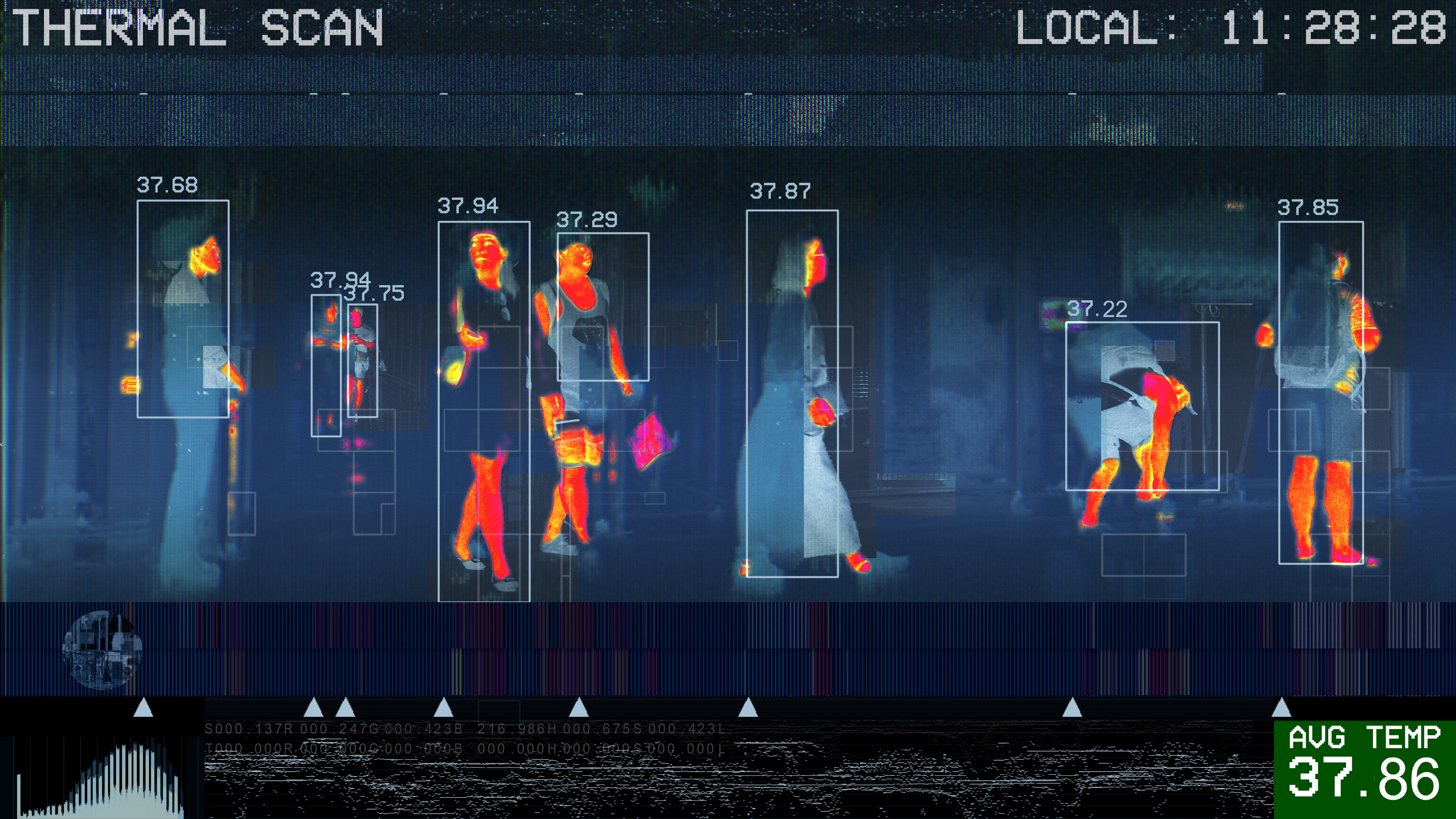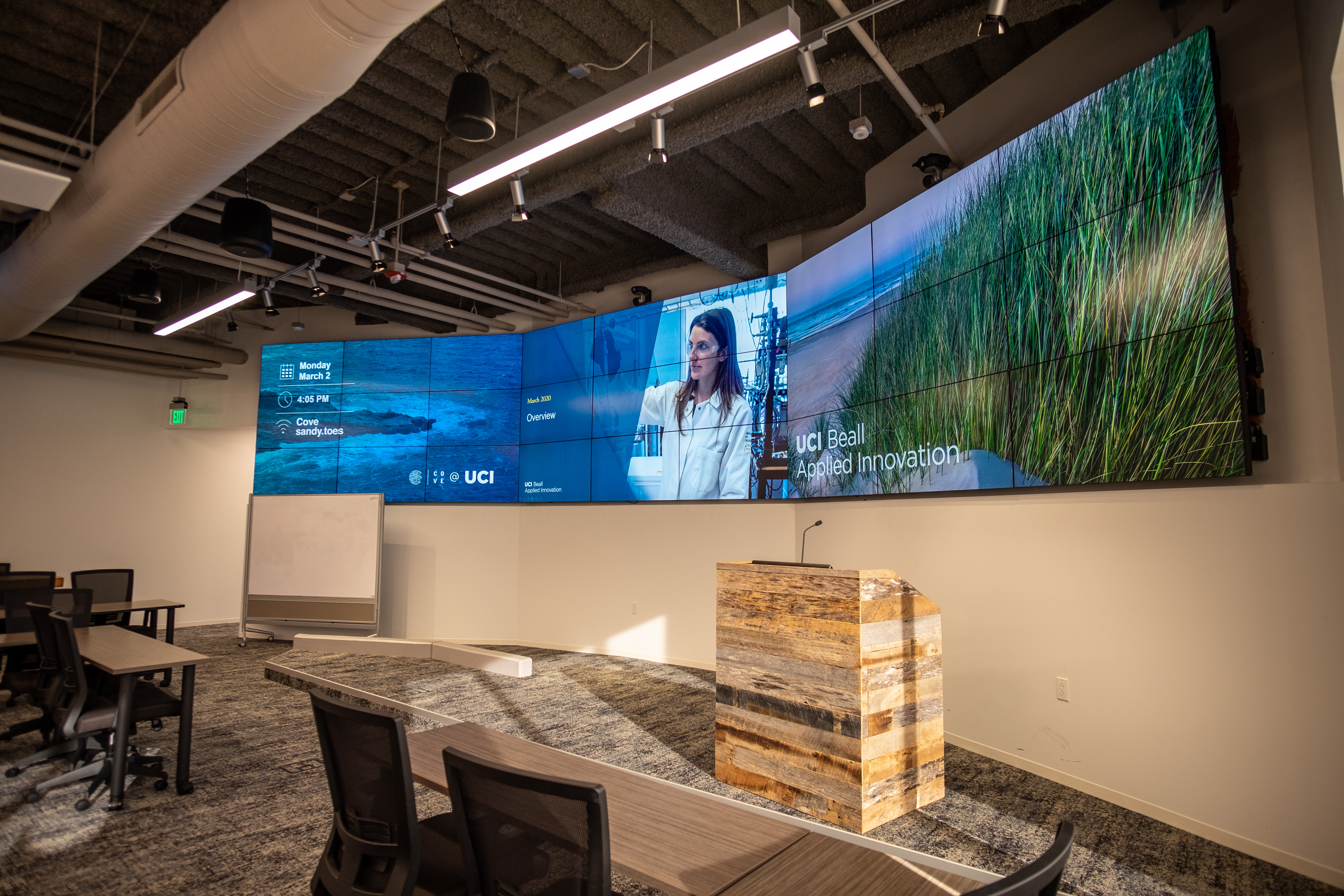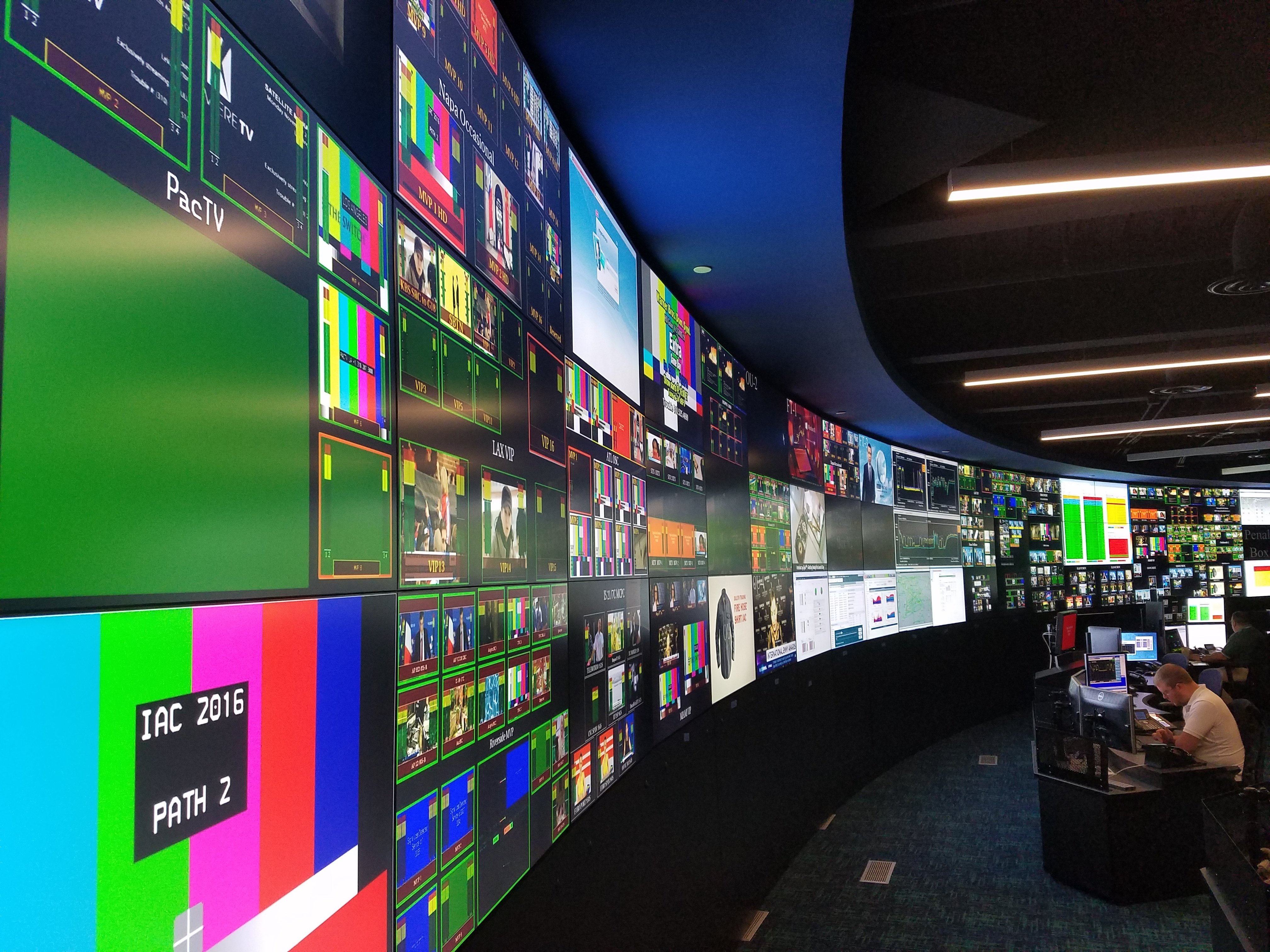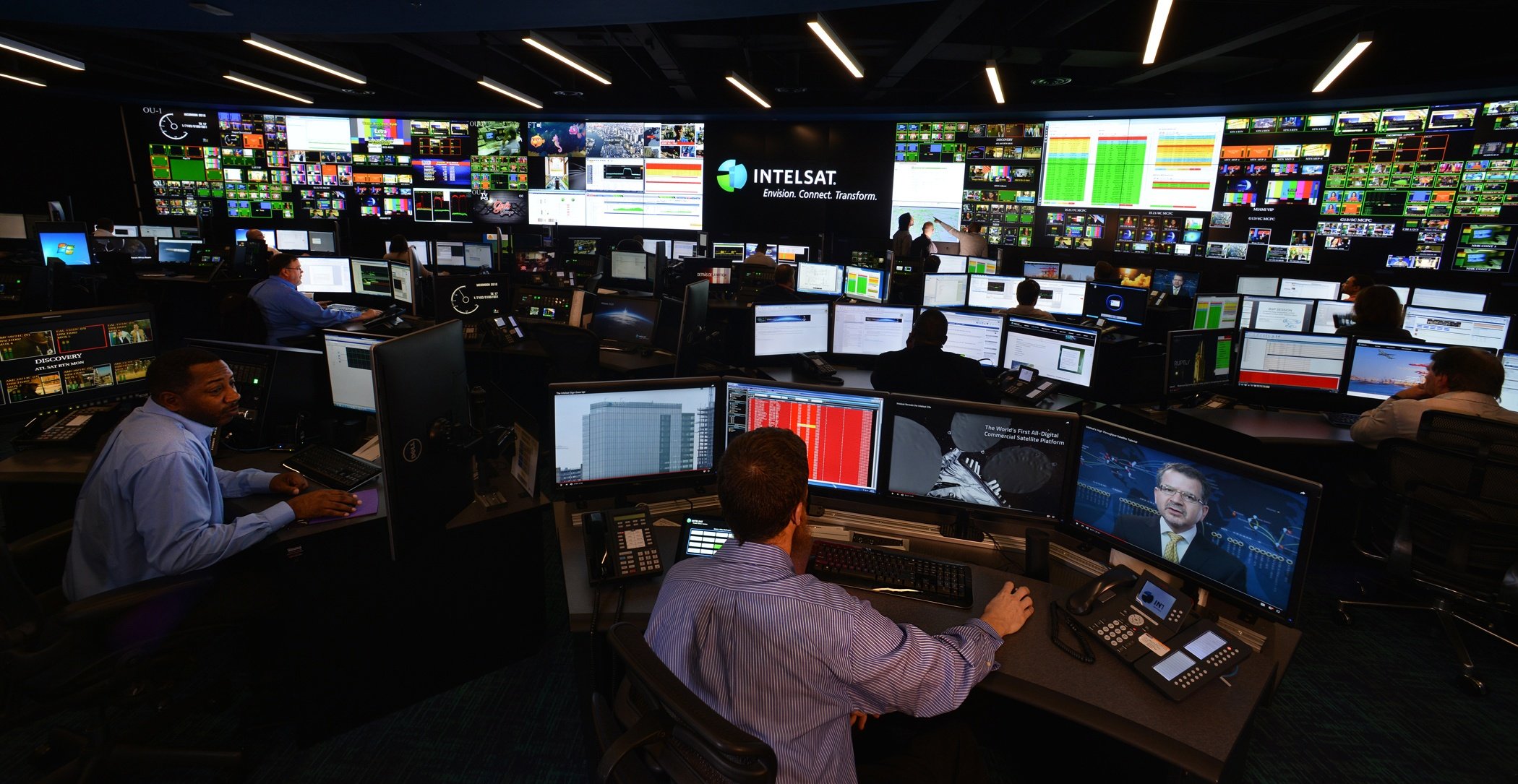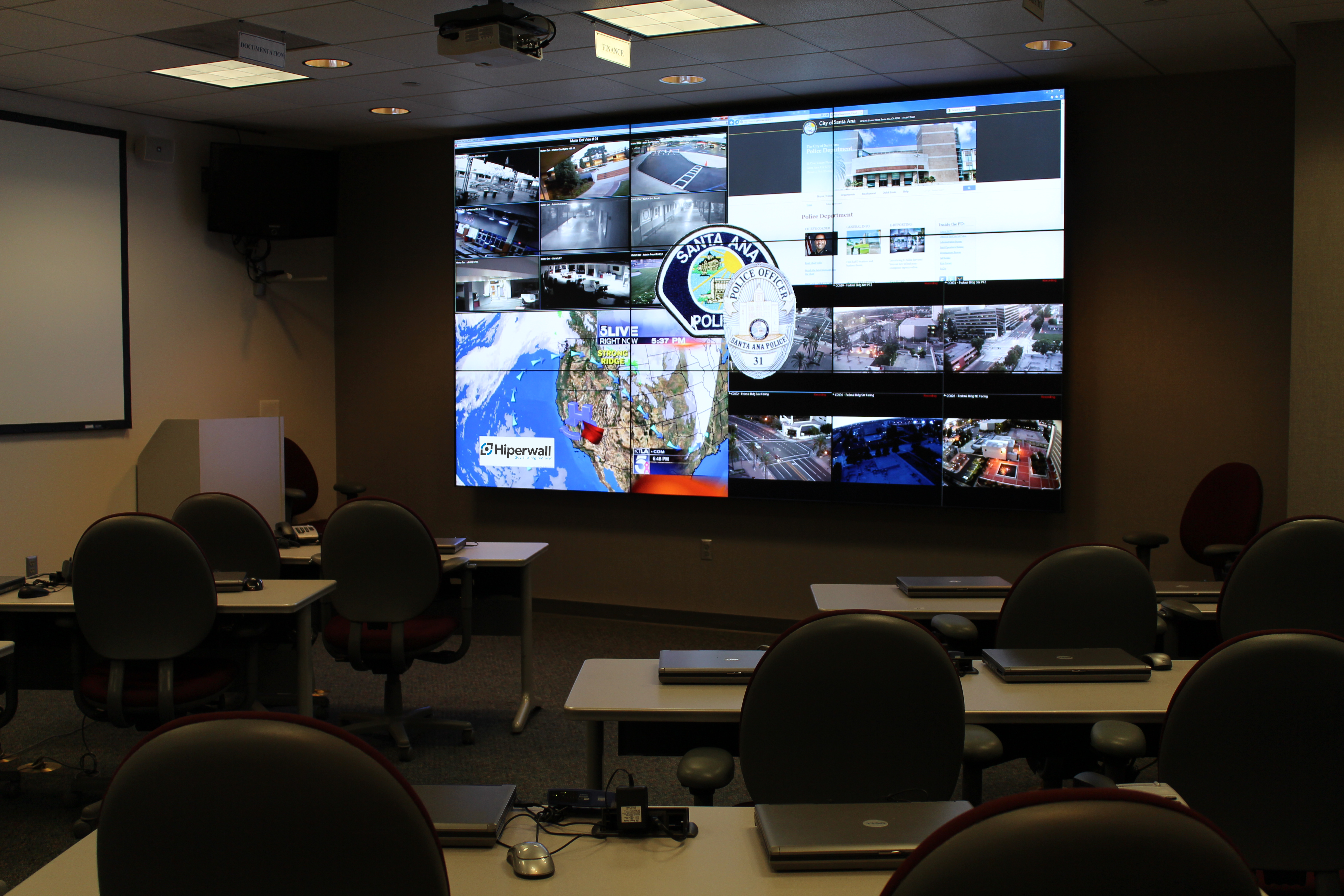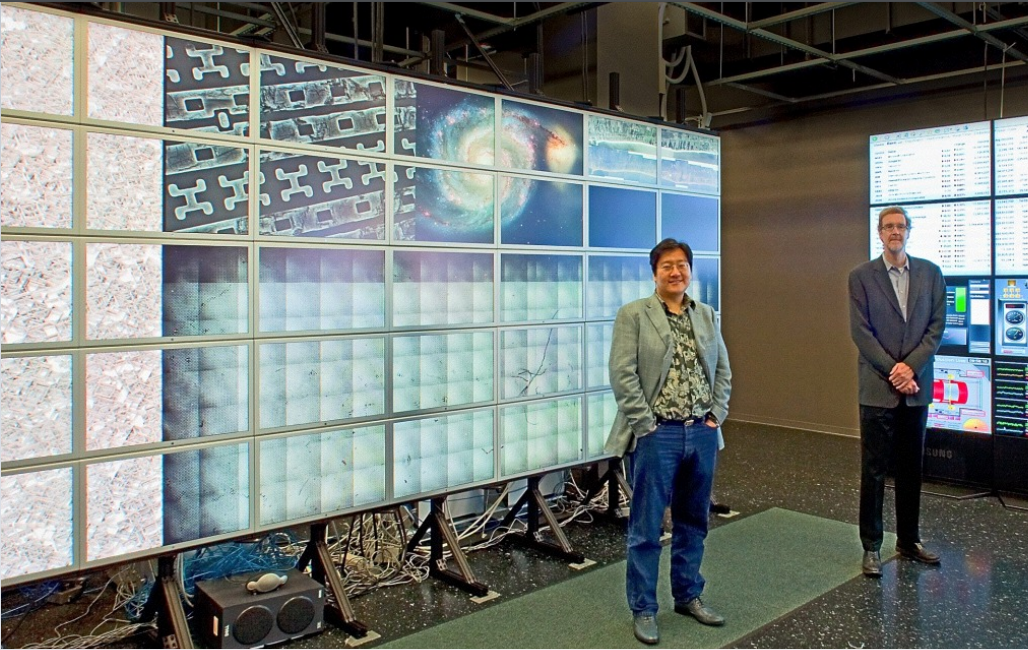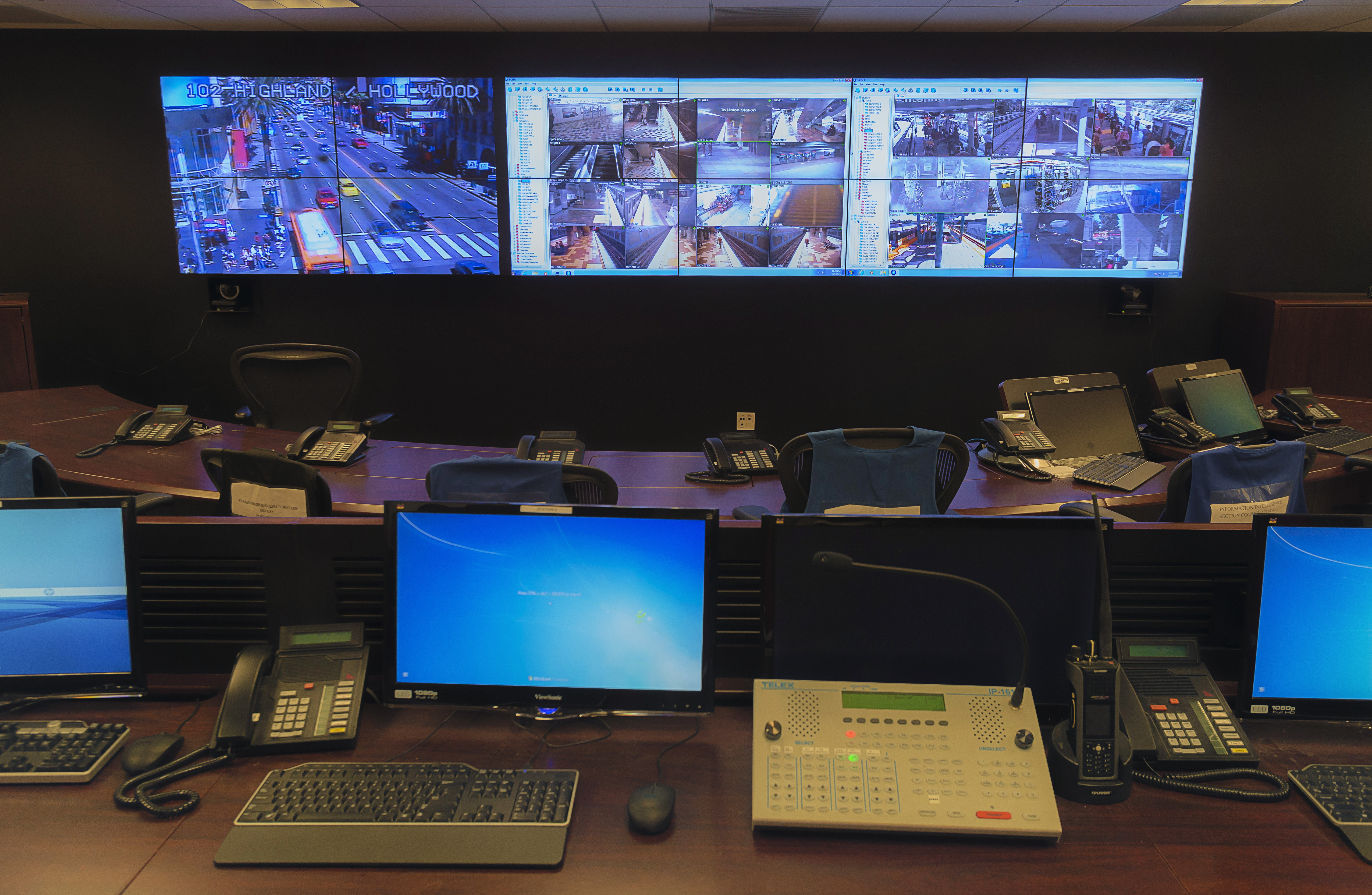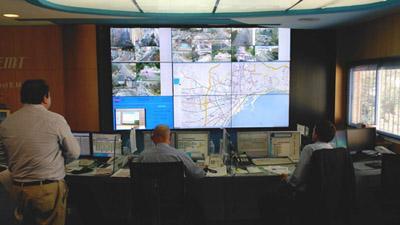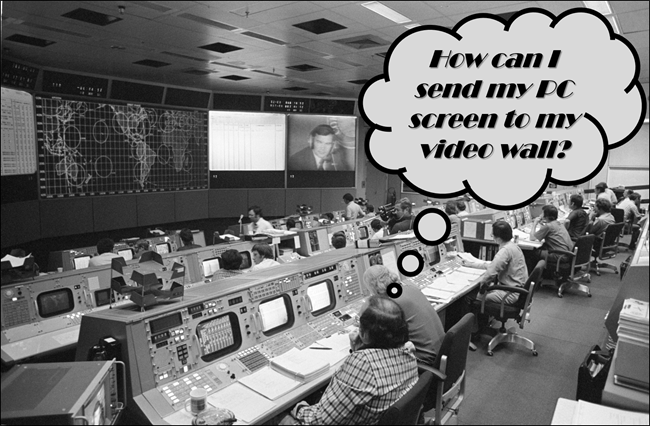We’re thrilled to announce that we’ve just launched Hiperwall Version 9!
2 min read
1 min read
Hiperwall's Video Wall Control Capabilities
By Michael Farino on Dec 22, 2023 6:51:39 AM
When it comes to advanced AV over IP video wall control, Hiperwall leads the way. This year at ISE, our friends at Sharp NEC showcased a variety of high-performance display solutions - all powered by Hiperwall's software-defined video wall control software. The demonstration at the Sharp NEC booth at ISE was a testament to the boundless capabilities of Hiperwall, offering guests a glimpse into the capabilities of our seamless, simple and extremely flexible video wall control technology.
2 min read
Version 8.5 is Here! We’ve Enhanced the Hiperwall User Experience
By Michael Farino on May 23, 2023 8:00:00 AM
We’re thrilled to announce that we’ve just launched Hiperwall Version 8.5!
5 min read
3 min read
Hiperwall Dev Team - 2022 in Review
By Dr. Stephen Jenks Co-Founder / Chief Scientist on Jan 5, 2023 11:27:18 AM
The Hiperwall software development team had a busy and productive 2022 with an outstanding video wall software release, and we’re preparing amazing stuff for 2023. Each member of the team designed, built, integrated, or tested complex software components that form the Hiperwall distributed video wall software product. Each team member expanded their capabilities by learning new techniques and skills to do a great job making highly capable and reliable software.
5 min read
The Evolution of Video Wall Sources
By Dr. Stephen Jenks Co-Founder / Chief Scientist on Oct 12, 2022 12:06:53 PM
Hiperwall video wall software has always been great at accepting and displaying lots of sources of several types, but sources and their uses have changed over the years as what they were showing evolved. This post contains my experiences with the changing landscape of sources used in Hiperwall video wall systems around the world, particularly for control rooms and similar, rather than signage applications.
6 min read
Content Integrity
By Dr. Stephen Jenks Co-Founder / Chief Scientist on Sep 23, 2022 12:15:02 PM
Hiperwall’s latest features that help keep your video wall’s content where you want it
1 min read
Hiperwall Development Team Year in Review 2021
By Dr. Stephen Jenks Co-Founder / Chief Scientist on Jan 4, 2022 10:45:39 AM
With the challenges of the global pandemic, the team mostly working from home, travel restrictions, and component shortages delaying installations, the Hiperwall development team had a banner year producing three important product releases! Our team’s ability to remain productive while working remotely is a testament to the team’s creativity and drive and the commitment of everyone in the company. Since we make video wall software, we need access to specialized equipment, including well-configured networks and video walls for testing, neither of which tend to be in most people’s homes. Remote access, cameras, and some trips to the office allowed the team to perform excellent work under austere conditions.
Notice: Hiperwall Not Impacted by Apache Log4j Security Flaw
By Dr. Stephen Jenks Co-Founder / Chief Scientist on Dec 23, 2021 10:43:31 AM
While the recently exposed flaw in the open-source Apache logging library Log4j remains a global cybersecurity threat, Hiperwall customers and partners can rest assured that Hiperwall software has never utilized any open-source Java libraries, including Apache Log4j.
2 min read
Hiperwall and Law Enforcement Command Staff Meetings | Video Wall
By Jonathan Gieg on Mar 30, 2021 10:38:41 AM
Hiperwall is a powerful software system where you can easily display and control information, data, and videos on a video wall comprised of multiple monitors or TVs. Read on to learn about how Hiperwall can help your law enforcement agency on a daily basis with command staff update meetings by encouraging a seamless sharing of information, without the clunky transition time.
2 min read
Using Hiperwall Software to Combat Wildfires
By Jonathan Gieg on Feb 24, 2021 2:07:42 PM
For new visitors that are not familiar with the Hiperwall system, Hiperwall is a powerful software system where you can easily display and control information, data, and videos on a video wall comprised of multiple monitors or TVs. Read on to learn about how Hiperwall can help your law enforcement agency in the fight against wildfires.
2 min read
Improve Information Flow In Dispatch Centers with Video Wall Solutions
By Jonathan Gieg on Jan 27, 2021 11:25:39 AM
For new visitors that are not familiar with the Hiperwall system, the ten second description of Hiperwall is that Hiperwall is a powerful software system where you can easily display and control information, data, and videos on a video wall comprised of multiple displays. In this blog post we are going to discuss dispatch call centers at police departments around the world, and how Hiperwall can help your organization optimize decision-making and the flow of information in these centers.
2 min read
Choose Assets That Grow With Your Business | Hiperwall Video Walls
By Jonathan Gieg on Nov 18, 2020 2:28:37 PM
In the business world it’s rare that you can purchase an asset that configures to all of your needs, will grow with you as your needs change, and is being constantly improved and updated over time. Consider some of the equipment or items that businesses purchase for operation: furniture, renovations to their property, property design, etc. In each of these cases the company has a sizable outlay of cash to purchase items that last a few years and then need to be replaced. If a company buys a couch for their waiting room, that couch will last for three, maybe five years, before it needs to be replaced due to being worn out or out of style. The company can’t add on to the couch or download an update for it; the couch is either in style and desirable or it’s old and now unwanted. And the same goes for artwork that a company might put throughout their building or space. Eventually they will tire of the art. It’s not going to change or evolve, they’ll either lose interest or the art will go out of style and it will need to be replaced. They won’t have any way to recoup their investment because they’ll have to give away the art or donate it.
2 min read
Better Decisions With Higher Resolutions | Video Wall Solutions
By Jonathan Gieg on Oct 26, 2020 1:56:51 PM
Today we want to talk about geographic information systems (GIS), or as they’re better known in every day use, maps. As the world becomes more accessible and we become ever more focused on precise travel and clear marking of territories, boundaries, and property lines, GIS technology is becoming increasingly important. At Hiperwall we believe that the products and services you purchase and interact with on a daily basis need to be an extension of your human capability and easily accessible for multiple people. Today we are going to dive into the two biggest benefits of empowering your GIS content with Hiperwall technology.
2 min read
Why You Want WYSIWYG And What It Means To Hiperwall Control Software
By Jonathan Gieg on Sep 29, 2020 3:26:20 PM
In today’s blog post we want to dive into an acronym you don’t hear of too often, WYSIWYG. WYSIWYG stands for What You See Is What You Get. And even though the phrase ‘what you see is what you get’ is used in other contexts in daily language, in the context of Hiperwall software WYSIWYG means that as you operate the Hiperwall control software you are seeing the exact changes that are being made on the video wall in real time. You simply click on content with your mouse, drag the content on the LED video wall, and manipulate the content using your mouse. Simple, and rapid. And that’s exactly why our customers choose Hiperwall, because in times of crisis or when your boss is looking over your shoulder waiting to see how well you operate the video wall, you want your software to be as easy to operate as possible.
3 min read
LCD vs LED Displays Differences | LED Video Wall | Hiperwall
By Jonathan Gieg on Sep 23, 2020 1:53:22 PM
Large LED Hiperwall video wall installation at The Cove, University of California, Irvine.
3 min read
How to Make an Impression With Your Corporate Lobby
By Jonathan Gieg on Aug 31, 2020 10:31:35 AM
When Hiperwall advises clients and partners on building video walls, a lot of the fundamentals remain the same in terms of hardware setup, content to be displayed, and the configuration of the environment. However, each video wall application has its own best practices and we thought it would be best to lay out more specific guidelines for each application as people design and install video walls. In this segment we are going to cover the ins and outs of video walls for corporate lobbies.
3 min read
Why Every Organization Needs a Network Video Wall Operations Center
By Jonathan Gieg on Aug 10, 2020 2:28:06 PM
Every successful business that is pursuing innovation and domination in their marketplace relies on technology to get ahead. Used properly and managed properly, technology is a force multiplier that empowers your employees to do brilliant work. And as technology improves and business become more reliant on technology, preserving this network becomes paramount to the daily business operations.
1 min read
HidraLink: What’s in a Name? | Multiple Display Video Wall System
By Dr. Stephen Jenks Co-Founder / Chief Scientist on Jul 13, 2020 3:18:00 PM
We have a shiny new visual communications product that makes it extremely easy to put content on multiple displays driven by a PC. It is especially powerful because it lets you manage displays that are not in line-of-sight. In addition, it can spread content across groups of displays for mini-video walls. But the name, HidraLink, seems to be spelled a bit funny.
3 min read
Secure Your Organization: Security Operations Centers | Hiperwall
By Jonathan Gieg on Jun 23, 2020 11:04:23 AM
In this post we are going to discuss another component of corporate environments that becomes increasingly important in a larger business’s daily operations, the Security Operations Center, or SOC. The SOC usually operates alongside a Network Operations Center, or NOC, another critical environment that we will discuss in a separate post.
3 min read
Engaging a Modern Audience: Rich Media | Video Wall | Hiperwall
By Jonathan Gieg on May 27, 2020 11:02:02 AM
Modern advertisers and marketers are in a constant cat and mouse game for the attention of the people they are trying to reach, across all platforms and at all times. The modern consumer, when out and about in normal daily life, will see thousands of logos and companies. The modern consumer sees the logos on their cell phones, on bus stops, on billboards, and building names. And the most common result of this logo inundation is that consumers become desensitized to the logos and the ads. The logos and ads start to become noise that consumers turn out.
3 min read
4 min read
6 Important Steps to Know Before Buying A Video Wall Solution
By Jonathan Gieg on Apr 21, 2020 10:43:51 AM
In the LED video wall industry, the customer’s buying journey is a labor of love. And at Hiperwall, we’re okay with that. We can move as quickly or as methodically as our customers and partners want. When you’re talking about large investments into the information sharing capabilities of your municipality or enterprise, you want to make sure you get it right from the beginning. You need an open dialogue with each of your partners involved in the process from concept to execution and installation. The buying journey can vary for each customer but in this post we want to explore the genesis of a customer’s interest in a video wall solution, all the way through to implementation of the video wall. Our hope is that you recognize where you are in this journey, even if you’re at the very beginning, and we can provide some tips to make sure you have a successful video wall installation.
2 min read
2 min read
Is Your Digital Content Boring Your Audience | Video Wall Solutions
By Jonathan Gieg on Mar 5, 2020 12:27:54 PM
2 min read
Stop Restricting Collaboration: Huddle Rooms of the Future | Hiperwall
By Jonathan Gieg on Feb 19, 2020 3:08:59 PM
2 min read
Traditional Corporate Digital Signage Is Dead | Video Wall | Hiperwall
By Jonathan Gieg on Feb 6, 2020 9:59:55 AM
Many modern corporate buildings are more than just an office for employees or a meeting spot for potential clients. Corporate buildings are “Second Homes” that employees want to take pride in and their customers want to be impressed by every time they enter the building lobby and walk through the offices. Corporations in the past have tried to make a positive first impression with greeters and receptionists, water displays, and even paintings and statues. Those attention-grabbing tools used to be enough to create a lasting impression on those who entered corporate buildings, but not anymore.
2 min read
Why Organizations Should Invest in Platforms | Video Wall Solutions
By Jonathan Gieg on Aug 27, 2019 10:53:37 AM
Is your company investing in standalone applications, or are you investing in enterprise-level platforms?
CIOs and technical leaders are always looking for ways to “do more with less” as they help their organizations become digitized. And if you haven’t read about the digital transformation that’s changing how companies monitor and deliver their services to their customers, you’re probably late to the party.
2 min read
3 min read
3 min read
A Guide to Digital Transformation - 2021 | Hiperwall Video Wall System
By Jonathan Gieg on Jan 8, 2019 3:08:12 PM
Updated 12/21/2020
Digital Transformation is the catchphrase that’s buzzing throughout most managerial discussions at companies about how an organization can improve and outpace its competitors. Even though all companies are becoming digitized, certain verticals such as utilities and energy companies have the added challenge of transforming legacy grids and IT infrastructure into modern, streamlined operations while continuing to deliver excellent customer service.
3 min read
How to Use Hiperwall in a Secure Environment – Part 2: Sources
By Dr. Stephen Jenks Co-Founder / Chief Scientist on Nov 13, 2018 11:51:09 AM
This article is the second of a two part series on using Hiperwall-enabled video walls in secure rooms or highly sensitive environments. The related articles will be linked here as they are released:
4 min read
Use Hiperwall in a Secure Environment – Part 1: Network Configuration
By Dr. Stephen Jenks Co-Founder / Chief Scientist on Sep 18, 2018 9:38:55 AM
This article is the first of a two part series on using Hiperwall-enabled control room video wall in secure rooms or highly sensitive environments. The following articles will be linked here when they are released:
5 min read
Do You Get What You Pay For In A Video Wall Solution? | Hiperwall
By Dr. Stephen Jenks Co-Founder / Chief Scientist on Aug 14, 2018 11:44:49 AM
The old saying “You get what you pay for” is commonly used when comparing high-end products with lower-end ones, implying the value of the high-end product is worth the higher price and lower priced products aren’t as good. With video wall controllers, there are exceptions to that guideline: expensive legacy systems may be less capable than more modern and less expensive options, while sometimes the lower-tier products have so many restrictions they’re not worth the hassle. Even if they don’t cost much, the limitations outweigh the cost savings.
3 min read
Control Room Video Wall Buyer’s Guide 2021 | Hiperwall Video Wall
By Jonathan Gieg on Jul 16, 2018 3:27:27 PM
Updated 2/20/2020
Control room video walls are often deployed in mission critical environments that require a level of sophistication and functionality above that of a standard digital signage video wall. It is important to choose a solution that has a proven history of success in these environments, so you can focus on the emergency at hand without worrying about the capabilities of your video wall.
3 min read
Video Wall Technology: AV vs IT Redux | Hiperwall Video Wall Solutions
By Dr. Stephen Jenks Co-Founder / Chief Scientist on Feb 21, 2018 5:14:00 AM
Now what does it mean to “process the data?” Processing the video data is very different from decoding a stream. Certainly, video streams must be decoded to play them, but in the IT-centric systems I’m talking about, that decoded stream is just data that can be processed and manipulated. Therefore, it can be filtered, modified, rotated, positioned, and sized as needed. It means monitor boundaries are not content boundaries. Content can be scaled from many items showing on a single Direct-View LED mesh or projector to large content items covering all or parts of many displays in a LED video wall, as shown in the following pictures.
These pictures show content overlapping, crossing monitor boundaries, and sharing space with other content on a single monitor. This can be done because the content is just data that can be processed and displayed, no matter whether it is an image, a video stream, a movie, or a data stream. Even compound content, like slideshows that contain other content items, can be manipulated, just like a simple video or a 2 billion-pixel image.
Lots of video wall systems can show one content item per display or group of displays, but far fewer can show multiple items per display, especially if some of those items cross monitor boundaries. Showing multiple items is a hard thing, even for solutions claiming to be IT, because they tend to just direct a video stream at each player computer driving a display. It is easy for Hiperwall, however, because we treat everything as data on a nearly endless pixel canvas that can show an enormous amount of content in detail. We can show hundreds of simultaneous sources across hundreds of displays of nearly any type and in nearly any configuration. We can do this because we are a true distributed system and don’t use a centralized server to process all the feeds. We let the computers driving the displays do the work of decoding, processing, and drawing content items they need, so there is no content bottleneck as there is in so many server-based systems.
One of our competitors recently put up a comparison chart trying to show how they compare to Hiperwall. Many of the claimed limits for Hiperwall are demonstrably and laughably untrue, but their feature claim I was most amused by is Picture-in-Picture. They claim we don’t have it, while they, of course, do. Well, since you’ve read this article, you know we don’t need to call out a Picture-in-Picture feature, because we can put any content wherever and whenever, so we can trivially put one content item in front of another one, and we can add transparency, so it is even better than traditional Picture-in-Picture. But just to prove the point when they read this, here is a video of a live video stream moving in front of another video stream in front of a huge live data feed of air traffic in the Los Angeles area. The moving video stream even becomes somewhat transparent as it moves in front of the other video stream. Sure, some of our customers don’t need to do all those things at once, but if they need to they can.
2 min read
Stony Brook University: Prepared for Disaster | Video Wall Solutions
By Jonathan Gieg on Nov 13, 2017 5:08:00 AM
Lawrence Zacarese, Assistant Chief of Police and Director of the Office of Emergency Management, wanted a platform to help aggregate various streams of information to be viewed at once in case of another emergency. They needed to consolidate the security infrastructure into an intuitive, responsive control room capable of alerting students, administrators, faculty and first responders in real-time. The platform needed to gather data feeds and bring all the disparate systems together to interact with one another and be displayed on a single LED video wall in the event of an emergency. Displaying all evolving information in a centralized location is crucial to effective decision making.
After Hurricane Sandy, Stony Brook University spared no expense in building an emergency management control room. The challenge at Stony Brook was all existing technologies, cameras, card access readers, fire alarms, burglar alarms needed to work together, but were living in their own independent silos. Bringing these groups together was key to mitigating another disaster situation.
Ston
The Stony Brook Emergency Operations Center is equipped with LG and NEC displays. In the center is a 3x2 video wall comprised of 55-inch NEC no-bezel displays, surrounded by eight LG commercial-style TVs that provide extra data, social media and television streams. The operations room is the central campus monitoring solution managing 124 buildings, more than 1,000 cameras and the Stony Brook University Hospital and Medical Center on 1,039 acres in Long Island.
Stony Brook may not be able to predict the next weather catastrophe or emergency situation, but it will be ready to activate the emergency operations center at a moment’s notice. Since completing the installation in 2015, Stony Brook has activated the emergency operations room for several situations including fires in campus buildings and potential threats for active shooter situations.
2 min read
Keeping a City Safe: Santa Ana Emergency Operations Center | Hiperwall
By Jonathan Gieg on Oct 30, 2017 5:00:00 AM
The SAPD Emergency Operations Center morphed from two main workstations in separate offices displaying surveillance system cameras on four large screens primarily designed to monitor the perimeter of the Police Administration Building to a Hiperwall-driven command center with nine 55-inch NEC, thin bezel, commercial-grade displays. The SAPD did not have a “true” video wall or visualization system in place prior to installing a Hiperwall-driven system which includes IP cameras, an enterprise-class network management system and a new fiber-optic backbone.
Knowing they needed a level of preparedness for potential disasters, the SAPD began reviewing LED video wall solutions for a command center. The SAPD ultimately chose Hiperwall because it was designed specifically for large display surfaces – it was a true visualization system. But more importantly, it gave the SAPD the centralized capability for displaying infinite data sources that could be viewed and managed effectively and easily. The Hiperwall visualization solution allows the Emergency Operations Center to receive any number of feeds from the 300-plus city-wide cameras, display the SAPD CAD system, National Weather Service satellite imagery, several social media channels, helicopter downlink video, SAPD video cameras, local news and much more.
In addition, their visualization system includes video content analytics to detect policy driven situations such as motion in restricted areas, loitering, overcrowding in public places, and more. Hiperwall seamlessly integrates access control and physical security systems allowing alarms and programmed events to be jointly managed.
During the winter storm, the SAPD Emergency Operations Center powered by Hiperwall became the command and control room video wall for the city’s agencies to monitor the city-wide cameras, satellite weather changes in real-time, city maps from Google Earth to view flood damage, traffic accidents, 911 calls, fire/EMS, and public works. All three city departments were in the Emergency Operations Center using the Hiperwall visualization system to collaborate which allowed them to be more efficient in resource management, triage calls and managing response times during the storm.
After discovering Hiperwall with all its capabilities, the SAPD stopped evaluating other video wall systems. Not only was Hiperwall an advanced visualization solution, it provided the SAPD the latest in technology and best practices for their Emergency Operations Center. It gave them a cost-effective solution that will grow with them. The Hiperwall software-centric solution requires only ordinary PCs, monitors, and a standard Ethernet network making Hiperwall a more affordable visualization system than traditional video wall technology. It’s ease of operation also expedited the training process, which effectively reduced manpower and operational costs.
Having a single location to gather and share information with those in the field and make risk mitigating decisions keeps the Santa Ana community safe. The incident will always dictate the necessary feeds and data requirements, but the SAPD is now prepared with their Hiperwall-driven Emergency Operations Center to manage or co-manage any situation.
2 min read
Hiperwall: What’s in a name? | Learn About Hiperwall Video Wall
By Dr. Stephen Jenks Co-Founder / Chief Scientist on Oct 25, 2017 4:58:00 AM
Hiperwall started as a research project at UC Irvine to build the world’s highest resolution (at the time) tiled display wall, more commonly known as a video wall. It was built to enable scientific visualization on an unprecedented scale, and we regularly showed imagery and data sets that measured hundreds of millions of pixels and gigabytes of data. From the start, we designed the system to be highly interactive and flexible, and we used parallel and distributed computing techniques to provide the high-performance visualization required to drive a 200 million pixel display system. Therefore, the name Hiperwall is an acronym of Highly Interactive Parallelized display Wall (yes, liberties were taken for the sake of readability).
At the time, we capitalized the name as HIPerWall, and we highlighted the IP in the name for two reasons. We used industry-standard Internet Protocol (IP) as the basis for our distributed computing infrastructure. We were also loosely affiliated with the OptIPuter project led by Prof. Larry Smarr of UCSD. Note that the IP in OptIPuter is also capitalized, because it was an IP-based worldwide distributed computing research project.
The Hiperwall name was chosen because we valued user interactivity and built the software to be highly interactive with very powerful rendering capability. This is easily visible in the video below that shows how smoothly and easily a Hiperwall system can zoom in on a 2 billion pixel image (rendered from a video game, Witcher 3).
How valuable is this interactivity to our customers? Many of our customers design their content using our interactive interface, but then they save that layout (we call it an Environment), so they do not use our highly interactive features on a daily basis. Where interactivity becomes essential is when a crisis arises or new information from a new source needs to be displayed urgently. Because our software is designed for easy interactivity, a system operator can quickly place the new source or image anywhere on the wall and even replicate it to multiple walls. Because of the interactive design features built into Hiperwall software, the ability to manipulate content quickly and easily is ready when our customers need it.
1 min read
San Jose, Costa Rica Airport Installs SITA ControlBridge | Hiperwall
By Sample Hubspot User on Sep 11, 2017 4:53:00 AM
The name of an operational control room video wall varies from airport to airport, but no matter what you call it, it remains the platform by which airports are able to facilitate the flow of information between the command center personnel and those in the field. It’s a complex and critical setup that collects and organizes large amounts of data for analysis and distribution.
To reduce errors and increase the efficiency and security of their mission-critical environment, the Juan Santamaria International Airport, managed by AERIS Holdings, selected SITA to implement its ground-breaking operational control room, ControlBridge, as the command center technology solution provider.
SITA partnered with Hiperwall, Inc. to utilize their visualization system software. Hiperwall software enables AERIS to integrate information from multiple security and operational systems such as video surveillance, CCTV and access control from a single, centralized location. AERIS requires 24/7 monitoring of air traffic control, customs and immigration, boarding gate security surveillance, ground handling, facilities management, fire suppression and air rescue. This allows for informed, collaborative decision making between the control room, personnel in the field and Costa Rican intelligence agencies. The SITA ControlBridge plays an integral role in providing the technology that enables the airport to quickly and effectively generate adaptive incident response plans for personnel in the field and be proactive in determining where improvements can be made at all levels of operation.
Hiperwall software helps integrate all existing disparate systems, achieve 24/7 fault tolerant reliability, enable safe operations and create scalability for future growth alongside the SITA ControlBridge. Most video wall solutions rely on proprietary hardware from multiple suppliers which drives up their cost and complexity and pushes LED video walls out of reach for widespread commercial use. Hiperwall software is a hardware-agnostic solution which means it is scalable, flexible, cost-effective, and lowers maintenance expenses and training costs for operational logistics.
Visit www.hiperwall.com to learn more about their video wall solutions and how they can help you.
1 min read
Why Companies Need an Executive Video Wall Command and Control Center
By Jonathan Gieg on Aug 21, 2017 4:49:00 AM
A command and control room would give any executive a significant advantage during large events and/or emergencies. It would allow them to assess numerous video feeds, news stations, social media activities, situational feeds of information, employee FaceTime feeds, security feeds, shared airport command center content in real time as well as standard and customized applications used to organize the information and collaborate before making a decision. Monitoring social media activity on a LED video wall is extremely beneficial for gathering intelligence on tweets and other communications to help diffuse incorrect information as quickly as possible. When utilized correctly, a video wall allows for a complete visualization of the magnitude of a situation and can significantly alter the way a company chooses to respond to an event.
During times of non-emergencies, the video wall can be used for business proposals, training and debriefings. Business proposal and training materials such as videos, online resources and PowerPoint presentations can be elegantly displayed on the video wall system and multiple feeds can expedite and improve the debriefing process.
Every company stands to benefit from having a centralized executive command and control center to monitor and control the company’s security and information flow. It is an integral asset that improves visual situational awareness and resolves inefficiencies within numerous levels of a company. It is unmatched in emergency situations in providing the most up-to-date information that enables strategic decision making and provides seamless collaboration between executives, upper management teams, operators and first responders.
4 min read
AV vs IT: Disruption or Evolution? | Hiperwall Video Wall Software
By Dr. Stephen Jenks Co-Founder / Chief Scientist on Aug 4, 2017 4:44:00 AM
The purpose of the technology behind a LED video wall or a digital signage system is to get content (typically video and images) to the monitors or projectors that make up the system. That technology may be simple or complicated depending on how many inputs and outputs are needed and how the content needs to be presented.
The industry has been moving away from traditional Audio Video (AV) technologies and more towards Information Technology (IT). Recent editorials in Commercial Integrator ( http://www.commercialintegrator.com/av/adam-forziati-av-industry-impressions/ followed by http://www.commercialintegrator.com/av/defense-adam-initial-impressions/) show this transition is well under way. The technology has become digital, and though the industry still needs AV knowhow (acoustics, sightlines, user experience), it also needs IT capabilities for networking, security, scripting, and understanding of resource usage.
Since the goal of content distribution for video walls and digital signage is to get content to the displays, I’m going to use a network analogy to explore some of the technologies. Some of us may remember the great debate between circuit-switched networking and packet-switched network. The phone companies, who were used to connect calls (thus switching circuits), were proponents of circuit switching. Circuit switching is a process in which a dedicated connection is established from the source to the destination before information can be sent. This dedicated connection offers reliable bandwidth, but has very poor resource utilization (much of the bandwidth may be unused at any given time).
The other approach, packet switching, shares bandwidth by routing chunks of information (packets) from their source to their destination along a data path that can be shared by many other packets. This approach allows for much better resource utilization and has been nearly universally adopted. As a side note, the telephone companies tried to compromise by proposing Asynchronous Transfer Mode (ATM) that was packet-based, but provided virtual circuit switching at the time a connection is established. It is used for ISDN and deep within some of the backbone networks.
How does this networking analogy apply to visual information distribution? The traditional matrix switch that switches an input to one or more output monitors is like a circuit-switched network – the path is dedicated from input to output. If that functionality is all that is needed, then such a non-shared approach is appropriate. We can argue that the traditional server-based video wall systems are also like the circuit-switched networks. They may not appear so at first glance because the inputs can be shown on any monitor or maybe several monitors, so the connection from source to destination (monitor) is not obvious. However, we need to think of the hardware server as the destination in this case. It is the component that renders the video to the displays, thus it is the constrained resource. While the server is a powerful machine, it has to accept all of the inputs and drive all of the displays so it can be overwhelmed if it has to do too many things at once.
Distributed system-based content delivery systems tend to lean towards the packet-switched network analogy. The network connecting all the sources and the many computers that drive the displays is a shared resource that is designed to support the delivering of many feeds to many destinations simultaneously. In addition, the amount of resources (computers, memory, network switch bandwidth) scales as the number of displays grows. It is entirely possible to overwhelm individual resources, but that doesn’t break the entire system. For example, one display computer could be overwhelmed by receiving and trying to decode more video feeds than its CPU can handle, but in a well-designed distributed system, only that display is affected while the rest of the system operates normally. As with packet-switched, even if one node gets bogged down, packet traffic still flows everywhere else in the network.
For example, the Hiperwall software treats all the connected displays as a huge canvas. Any of the content can be shown anywhere, from a small portion of one display to partially covering several displays to the entire video wall or signage system. All the content is digital and shared as needed on the network (capture cards can digitize video sources, for example), and thus can be distributed to any or all the computers driving the displays. Of course, putting too many 4K videos or high-bandwidth streams on a single display computer may cause that computer to stutter while playing the content, but the rest of the system is unaffected by that overload condition. Because of the distributed, shared nature of the system, it can display a huge amount of content, including multiple streamed or stored content items per display, while scaling to hundreds of displays showing live streams.
There are many products in the industry that take advantage of IT (IP networking, modern processors, etc.), but are really providing point-to-point solutions (digitize video here, display it there). These are like Asynchronous Transfer Mode, in that they provide packet-based virtual circuit switching. There isn’t anything wrong with these products if you need the equivalent of a really long HDMI cable, but they don’t scale and aren’t as flexible as systems that provide a shared canvas to draw many content items.
In short, the content display industry, including video walls and digital signage, has been transitioning over the past decade from traditional dedicated AV hardware (circuit switching) to a commodity-based IP networking IT infrastructure that can provide resource sharing, flexibility, and fewer constraints. This transition is lowering costs, enhancing capabilities, and supports unprecedented scalability, which is important in a world where displays are all around us. As displays become ubiquitous, the hardware, software, and networking technology to drive their content must scale appropriately.
3 min read
Hiperwall Version 4.6: Streaming at its Best | Hiperwall Video Wall Solutions
By Sung-Jin Kim, Ph.D. Co-Founder / Chief Technology Officer on Aug 3, 2017 4:40:00 AM
Although this worked well, we saw room for improvement. The question for us was: What is the cost of improving performance on the computing/networking resources? To answer that, let’s take a look at the four steps involved in streaming a desktop screen, for example.
Step 1. Capture
Certain resources are required to capture the desktop screen. This process can be fairly CPU intensive, however starting with Windows 8.1, Microsoft began providing a very efficient method of capturing a screen. Because of this, the CPU usage cost was lowered and became reasonable, at least from our point of view.
Step 2. Compress/encode
The raw data of a captured screen is too big to send over a network -- it needs to be compressed in some way. In our original Streamer, we used a light compression technology assisted by a modern GPU such as an Nvidia graphics card. This methodology required a more powerful GPU, but CPU usage was reduced. Compression became easy to render and display on the receiving side, but it also used a lot of network bandwidth.
Step 3. Sending over the network
Even though we compressed the data, it still required a massive amount of bandwidth to be sent over the network. Streaming a 1920 x 1080 screen at 30 FPS consumes about 51% of a gigabit network. With a properly configured switch, multiple streams from multiple sources could go to multiple destinations, but misconfigured switches could easily overwhelm the entire network.
Step 4. Render and display the stream
On the receiving end, a portion of the video wall that will display the stream receives it and renders it. Our old approach using light compression was extremely easy to render. Fairly low-level machines could be used to display streams without too much effort.
As you can see, our strength in utilizing resources was in Step 2 and 4. Our greatest weakness was in Step 3 where the network bandwidth became the bottleneck of streaming. Even though we could perfectly meet the customer demands of having multiple video streams on the LED video wall, the network infrastructure had to be setup appropriately and required special care.
Today, people want to stream higher resolution screens with higher frame rates. Upgrading to a larger network bandwidth such as a 10 gigabit network will accommodate this of course, but it doesn’t actually solve the problem.
So, we looked back into our design and decided to focus on improving Steps 2 and 4 in order to reduce network bandwidth usage. This makes the most sense since computing resources such as the CPU and GPU continue to get faster and more powerful, while network bandwidth remains mostly the same. In a perfect world 10 gigabit networks would be widely available, but we are not holding our breath for that to happen.
In Step 2, we added an industry-standard H.264 encoding engine which encodes a 1920 x 1080 screen at 60 FPS comfortably using modern CPU/GPUs. Then we added our own special patent pending sauce to serve our specific purpose. The result is that the network bandwidth (Step 3) is now reduced to about 50-100 Mb/s, or 5-10% of a gigabit network which reduces the burden on network infrastructure and enables more simultaneous video streams across the video wall. As an added benefit, the encoding engine also allows for much higher image quality than our old compression engine.
In Step 4, the receiving side decodes and renders the stream, which is more work than before. However, since most CPU/GPUs these days include very efficient methods of decoding H.264 streams, the CPU/GPU resource usage increases only by a little.
With this rebalancing of resource usage, we can achieve very efficient streaming with improved image quality and a network bandwidth reduction of about 10 fold.
We place a lot of emphasis on future-proofing. Our software technology can easily adapt to hardware improvement. When more powerful encoding/decoding hardware engines are available, our software engine will be able to utilize them to provide higher resolution streams with minimal network bandwidth increase.
3 min read
We Know Control Rooms | Video Wall | Hiperwall Control Software
By Sample Hubspot User on Jul 11, 2017 4:35:00 AM
We understand that there are a lot of design elements that go into a control room video wall installation, but none are more important than planning for the optimum presentation of content and organization of that information. Your focus should be on the purpose of the control room, and how the installation effectively facilitates information transfer in order to mitigate risks in decision making.
Once you understand the decision-making objectives of the video wall, the second step is displaying that information on a video wall in an organized manner so that the operator can efficiently use and interpret it. It is essential that the operator has immediate access to all of the required information needed to quickly assess a situation, maximize situational awareness and take the appropriate action. The platform used for organizing the information must be simple to add, move, resize and remove content regardless of visual technology offered in the video wall. The operator needs to be able to zoom and position any content as needed, utilizing the full resolution of each screen and maintaining full control over all data sources. Visualization on high resolution video walls provides a comprehensive overview of information needed to identify problems and to optimize processes to enhance decision making.
The control room is all about creating an environment that facilitates an increase in situational awareness while utilizing visualization tools that transfer information to a common operating picture (video wall) and/or the operator. This is where daily decision-making affects corporate goals and returns on plant assets. Content, organizing and manipulating the information, and optimizing the control room design are important aspects of a successful operation.
Whether you need to remodel and optimize your current control room, consolidate operations or build a new control room, there are new standards to assist in design. Early control rooms were historically crowded and disorganized. Today, we have a set of standard guidelines published by the International Organization for Standardization. In particular, ISO 11064 lists the standards for ergonomics in the design of control centers, as well as the layout and dimensions of workstations for maximum efficiency. The standard is divided into seven key parts:
- Principles for Design of Control Centers – as a human centered approach, the design begins with the operator.
- Principles for Arrangement of Control Suites – square footages are determined, adjacent areas pre-determined, and the space is laid out to facilitate all activities.
- Control Room Layout – ergonomic principles are applied to layout and maintenance.
- Layout and Dimensions of Workstations – needs of the operator will determine the overall dimensions of visual-display-based workstation.
- Displays and Controls – maximize safety, reliability, efficiency and comfort for the human operator interface.
- Environmental Requirements for Control Centers – lighting, acoustics, temperature, humidity and vibration all are key factors that play into operator awareness.
- Principles for Evaluating Control Centers – lessons learned and documented for making future improvements.
You can learn more about ISO 11064 and how the standards can assist in establishing a design that achieves maximum control efficiency with this link: https://www.iso.org/obp/ui/#iso:std:iso:11064:-4:ed-2:v1:en
We know control rooms. They are invaluable assets that enable individuals or groups to view large amounts of information through an organized and centralized platform. If you are refreshing or installing a video wall for the first time, you will want a video wall solution that is simple to navigate and features an ultra high-resolution display system with scalable size that can support a combination of still images up to 1GB, HD videos, HD streaming content and PC applications. Hiperwall can assist you in determining your needs and specifying a video wall for your control room. We also offer solutions for digital signage, trading floors, education and the presentation of high-resolution images in science, medicine or urban and rural planning. Give us a call, we are here to help.
4 min read
External/Programmed Control of Video Wall Systems | Hiperwall
By Dr. Stephen Jenks Co-Founder / Chief Scientist on Jun 5, 2017 4:31:00 AM
Usage Scenarios
Why is external control important? It depends on the usage scenario for the video wall. If the video wall is digital signage, the contents can be automatically changed based on sensor inputs that detect who is looking at the wall. Such sensor systems can detect/guess gender and age of viewers, so the signage contents can be changed to present material appropriate to the audience.Such sensor systems can detect/guess gender and age of viewers, so the signage contents can be changed to present material appropriate to the audience.
In a control room, systems monitoring factory equipment or network health can bring particular data feeds to the foreground of the video wall if problems are detected. A security operations center could have software monitoring social media feeds and pop up a map on the video wall if it detects threatening comments. A surveillance system could show a video feed if it detects an intruder.
The API also allows integration with third party room controllers, like AMX and Crestron systems, that can provide a simple one-button approach to configuring the LED video wall content, room lighting, speaker volumes, etc. Many video wall customers want such integration, so some sort of API or external control mechanism is essential.
Options
There are several ways to implement programmable control for video wall systems. One way is to integrate a scripting language, like Lua or Python. Other industries have taken this approach: several popular multiplayer online games incorporate Lua to allow customization of the user experience. If a video wall system incorporated such a scripting language, developers could write programs that call the video wall system’s API to show and manipulate content. This allows tight integration, but the video wall system must provide mechanisms required for the script programs to communicate with external systems, all of which must be maintained and secured. It also requires that the customers’ programmers learn the specific scripting language chosen by the video wall company. We chose not to take this approach at Hiperwall.Hiperwall’s Network-based Approach
The approach we chose is to define a network API called HiperServices loosely based on a Web Services model. In this case, a client program (which can be written in nearly any programming language) sends an HTTP request to the video wall system to ask it for information or to command it to perform a task (show or manipulate an object, for example). These requests can get information about the video wall system itself (walls and their sizes), available content items, as well as content already on the wall. They can also command the wall (using a simple XML statement) to show a specified content item at a certain place with certain properties, including transparency, layering, color filters, and more. In our API, client programs specify an identifier for each object they show on the video wall. This can be thought of as a variable name in a programming language, so that identifier can be used in the future to manipulate that object or close it. XML-based commands can be used to move an object on the video wall or change other properties, making it stand out by turning it red, for example. These “change” commands can be chained and queued with a time parameter, thus animating an object in any way the client program desires. For example, wiggle the object to get attention, make it transparent and show what is behind it, and even more.This very powerful network-based approach allows programmers to use programming languages they prefer, yet provides a flexible set of tools that can make the video wall and its content do amazing things. One of the earliest examples of the use of the XML-based API is HiperPong, a simple version of the video game Pong written to use the Hiperwall video wall. It is a small Java program that queries the wall size and available contents, then lets the user choose which content items will be used for the paddles and the ball. It then allows the user to control the paddles on each side of the video wall to play pong. Because it can use any object as the ball, for example, it can show a live video stream flying back and forth across the video wall rotating as the paddles hit it. The video below shows HiperPong in action.
The HiperPong program uses very simple physics to determine where the ball should be going, then it uses the HiperServices XML-based API to command the ball to move to the right location over the next 20th of a second, then when that 20th of a second has nearly expired, it does it again. This built-in animation capability allows the ball, paddles, and even the score numbers to move reasonably smoothly on the video wall without having to control the movement each frame (60 times per second).
External control of a video wall system is a powerful feature that allows the video wall and its content to be controlled via client software and third party video wall controllers. It allows the content and layout to react to external events from social media feed monitoring, surveillance systems, or other control systems. Hiperwall’s tool kit, HiperServices, allows a video wall designer to create a dynamic video wall solution that meets the requirements of each unique usage scenario. It also adds animation capabilities that provide freedom and control to empower design creativity.
2 min read
Maximizing a Video Wall Experience | Hiperwall Video Wall Solutions
By Robert Cameron Manager of Global/Key Accounts on Apr 13, 2017 4:27:00 AM
What do you most need to know about making an informed decision when designing a video wall? All too often, system designers, contractors or integrators do not always design a video wall aligned with the customer’s realistic goals, budget, and environmental limitations. Obviously, you’re looking for a solution that delivers a strong return-on-investment for both the current need and ability to expand in the future. Here are some considerations to help maximize your video wall design:
1) Determine how your video wall will be used today and in the future. Knowing the requirements for the video wall will drive the selection of the right video wall software and hardware.
2) Content is critical to your video wall system. Which of these will be showing on your video wall? Still images, low-res/high-res videos, 4K content, HTML5 applications, and 3D graphics? Once you know what kind of content you’ll display, then consider how it will be delivered to the video wall.
3) Know your environment and limitations. Before specifying a video wall system, be aware of the environment of where the video wall will be placed. Physical dimensions, room space, layout and ambiance will determine the appropriate size for your video wall.
4) Consider alternatives for future-proofing your technology without blowing the budget. You need flexibility in your design to ensure your video wall will grow with your future requirements.
5) Select the right technology. A well-designed video wall and the correct technology working together in your operations center enable the best results. There are so many ways to specify and implement a video wall that it can be hard to cover every approach. However, all video walls require an array of high quality, commercial or professional grade monitor screens configured to create a larger screen – video wall.
- The traditional proprietary hardware suppliers use video wall controllers that are designed around their own technology with multiple built-in video outputs. There are expansion limitations with this technology and you are committed to a single vendor for the life of your video wall. Also, it is expensive.
- Next generation video wall systems are based on new distributed visualization software that is transforming the industry by eliminating the need for specialized servers, matrix switches, tangled cables and time-consuming training in favor of a solution that is easy to install, easy to use and easy on the budget. Hiperwall, for example, has eliminated these barriers by developing a software-based video wall platform that is completely hardware agnostic and budget friendly allowing users to deploy systems with nothing more than commonly available PCs, monitors and network equipment.
3 min read
How can I send my PC screen to my video wall? | Video Wall Solutions
By Sung-Jin Kim, Ph.D. Co-Founder / Chief Technology Officer on Mar 28, 2017 4:23:00 AM
Introduction
That is one of the most common questions we get from Hiperwall customers. Hiperwall’s HiperSource software family provides several different ways to accomplish this fundamental feature of a video wall.What is HiperSource?
HiperSource is a component of the Hipewall system that enables remote content viewing on a Hiperwall enabled LED video wall. It includes three different programs, HiperSource Sender, HiperSource Streamer and HiperSource IP Streams. Each program is designed to stream a PC screen and each has its own strengths and weaknesses.First the user should decide how many “sources” he wants to see on the wall simultaneously. That number is the HiperSource license count. Then the user can mix-match any combination of HiperSource Sender/Streamer/IP Streams to meet his needs.
HiperSource Sender
Sender is a Java application that the users can install on any computer that supports standard Java (which excludes mobile devices, unfortunately). HiperSource Sender captures the whole screen or a region of the screen and sends it to the Hiperwall system through a SSL encrypted TCP channel.It is designed to capture a large screen which can have a resolution as high as 8000 x 3000 pixels or more, for example. It provides slightly lower framerates and is ideal for more static contents.
It provides keyboard video mouse (KVM) functionality meaning, the human operator of the Hiperwall system can remotely control the source PC that sends its screen.
Capturing and sending a desktop image relies heavily on the CPU and HiperSource Sender can utilize multiple-cores in a CPU. More cores, better the performance.
HiperSource Streamer
Streamer is a Windows® application that users can install on any computer with an Intel or Nvidia graphics card onboard. It can stream three different types of video to Hiperwall, 1) video from a file, 2) video from a capture device, and 3) complete desktop capture or partial capture. If the PC with HiperSource Streamer installed has a capture card inside, it can stream any video coming out of the capture device. Also, the Streamer enabled PC can capture whole or part of the desktop screen and stream it to Hiperwall.HiperSource Streamer is ideal for video oriented content but requires a heavy network bandwidth.
Capturing desktop and sending relies heavily on the CPU and network.
HiperSource IP Streams
HiperSource IP Streams is a Windows® application that receives IP streams coming from any ONVIF compliant camera or RTSP streaming device. It contacts the IP camera or RTSP streaming device and relays incoming IP streams to the Hiperwall software with minor modifications to the stream. It’s designed to handle about 30 incoming and outgoing IP streams in a moderately configured PC.Multiple network interface cards can be used to separate the incoming network and the outgoing (to Hiperwall) network.
Which one should I use?
It depends. Each one is designed for different cases. After carefully defining what the user wants to see on his video wall, he can choose based on his needs.If you want to show cable TV, then HiperSource Streamer with a capture card or HiperSource IP Stream with a H.264 encoder device is ideal.
If you want to show live video feeds from a PC, then HiperSource Streamer can be installed on that PC, or a separate Streamer PC with a capture card that can capture the output of the video feed PC.
If you want to show content of the PC that is outside corporate network and requires secure network communication between the PC and Hiperwall, HiperSource Sender is the choice.
In the end, Hiperwall can accept any type of “source” from each of the HiperSource programs and the user can design the system that meets his needs.
2 min read
Future-Proofing: “To infinity and beyond” | Video Wall Solutions
By Bob Maples on Mar 21, 2017 4:13:00 AM
Hiperwall software powers the most cutting-edge video walls and distributed visualization systems today and beyond. It future-proofs your video wall because it’s hardware agnostic and can be assembled with any brand of display, PC or network gear. With Hiperwall software you can design in new hardware technology, expand and change displays, and incorporate distributed visualization without buying new proprietary hardware. It just takes a simple upgrade to Hiperwall software.
Before you leap into specifying your video wall needs, ask these questions to be sure you can take your video wall beyond today’s needs:
5 min read
Hiperwall Fault Tolerance | Video Wall Solutions | Hiperwall
By Catherine Scott on Mar 14, 2017 4:08:00 AM
Defining Fault Tolerance
We must be clear: fault tolerance is not fault proof. As the name states, it tolerates faults, and the goal is to make that tolerance as seamless and painless to the user as possible. The basic idea of Hiperwall Premium Suite fault tolerance is that if one of our controllers fails or goes away for any reason, a second video wall controller will continue to operate the wall with as few noticeable transition effects as possible (more on this below).
Why did we focus on this kind of fault recovery? Our customers were concerned that if something happened to their Hiperwall enabled controller PC, it could bring their system down. Since the controller PC is a commodity computer, it could suffer a hardware failure (typically fans failing or drives dying), a careless visitor could kick the power cord or knock over the PC if it isn’t in a rack, or most likely, an operating system update could cause the system to reboot for several minutes while the updates are applied.
Solutions
The most obvious solution to a controller failure is to have a second controller. Luckily, with Hiperwall’s distributed visualization architecture, the HiperView enabled computers driving the displays are doing much of the work, so the controller software just runs on an ordinary PC and the added hardware expense is minimal. Adding a second controller has the added benefit of allowing a second user to actively control the system, an approach called “active-active” in distributed computing circles (as opposed to an active-standby approach). Thus a Hiperwall Premium Suite system has two active controllers that operate in parallel and can both control the wall simultaneously.
Other fault tolerance techniques that we rejected include triple modular redundancy (TMR) and voting systems, like those used in the space shuttle. They solve different problems than our fault tolerance solution does: they deal with a cosmic ray flipping a bit and causing a calculation to come out wrong, thus breaking the trajectory of the vehicle. Our premise is that as long as the hardware is working, it is producing correct results, but when it stops working, we need to detect that and recover.
Detecting Faults
Detecting faults in networked computer systems is a challenge, because computer networks are not reliable when they get busy. Switches drop packets when their buffers fill up, so we can’t rely on a single missed packet, for example. Network stacks (the software in Windows that sends and receives traffic on the network and implements communications protocols) are often tolerant of network disruptions, thus they don’t report connection failures for a long time. We had to develop techniques to detect that a fault occurred quickly, yet not be plagued with false detections. This required a multi-faceted approach with several monitoring channels and other low-level techniques to detect that the other controller has gone away and to take over the system if needed. In doing so, we had to define “primary” and “shadow” controllers, though the distinction is not apparent to users. The determination of primary and shadow occurs with an election process at system startup, so neither controller PC is always either primary or shadow, and neither is more capable than the other.
Testing
Testing fault tolerance was a significant challenge, because we wanted to make sure we tested failures that could affect our customers and those that they are concerned about, not just arbitrary failures that make the fault tolerance mechanism look good. Some of the test conditions were easy to do and replicate: pulling the USB license key, for example, can be performed over and over with identical results. Quitting the controller software or restarting the computer are similarly reliable and easy to detect and recover from. These produced nice, clear failure modes, because all the network connections were closed cleanly, thus failure detection is quick and easy (determining what actually happened is more challenging, but at least the controller knows that the other one is no longer connected). Pulling the power plug from a computer or causing it to “blue screen” (which we wrote a test program to force) were more challenging to test. These are somewhat dangerous operations, because they could corrupt the PC operating system or drive contents, so performing them often could lead to time consuming drive re-imaging. They also result in failures that are difficult to detect: the computer stops communicating, but the connections remain open for many seconds. This kind of failure was a great test for many of our timer-based fault detection algorithms.
Another kind of fault testing we perform is network failure. Network switches are extremely reliable, so we didn’t need to test for that kind of failure, but network cable pulls and intermittent connections can happen, so we test for those. A network cable pull is much like pulling the power cord, in that the computer stops communicating, but the network connections don’t timeout for a while. Intermittent network connections or cable pulls followed by quickly plugging it back in are much more insidious problems and are hard to diagnose. A very short cable unplug/re-plug is something most networks can tolerate with no disruption, so Hiperwall tolerates it with little to no interruption. A longer interval (half a second to a few seconds) between unplugging and re-plugging is one of the trickiest faults to detect and recover from, because the network is clearly disrupted, but not all the connections are broken. In this case, we choose to fail over to the other controller that did not have its network disrupted. This requires substantial coordination, because the controller that had the network failure needs to detect that it was interrupted, so when it is re-connected, it does not try to assert its old state, but instead negotiates with the other controller. The controller that didn’t fail needs to detect that it is no longer connected to the other controller, but it is still connected to the rest of the system. If it wasn’t already the primary controller, it then becomes the primary and takes over management of the system.
Behavior
So what sort of behavior should a customer expect with a Hiperwall Premium Suite system when a controller fails? If the failed controller was the “shadow”, then there won’t be any effect, other than the failed controller can no longer control the wall. If it was the “primary”, there will be a short transition period as the old shadow controller becomes the primary and takes control of the system. On the displays, much of the content, including most HiperSource streaming content, will remain visible and continue updating without interruption. The exception is for Sender content from outside the LAN, for example HiperCast Senders or other remote Senders. They were connected directly to the failed controller, and it will take them a few seconds to change over to the new primary controller, but they will resume updating within 4-5 seconds typically. This means that a mission critical wall in a NOC or other control room will remain operating and only experience very minor disruption even if one of the system controllers fails. In a typical digital signage scenario, the failure of one of the system controllers won’t affect the displayed content at all, so no disruptions.
What kind of faults don’t we tolerate? The network switch failure mentioned above is the biggest example, but (a) switches are extremely reliable, and (b) our engineers have experimented with ways to failover to a second switch, but it requires very specific hardware. We obviously can’t do much about the failure of a display. We also don’t do anything about the failure of an individual computer running HiperView software and driving a display. As with a display failure, this doesn’t affect the functionality of the entire system, but just affects one display. Since the display PCs are typically commodity PCs, it is quick and easy to repair or replace them. Bringing a new HiperView PC online just takes a few minutes.
Conclusion
We designed the fault tolerance features of the Hiperwall Premium Suite to recover from the most common failures that can take a videowall system offline, including common hardware failures, mistakes, and accidents. It keeps the wall running in critical situations, but doesn’t require duplicating all the equipment nor the enormous extra cost that would take. We designed it to be as easy to use as all previous Hiperwall systems, but with extra peace-of-mind that can help all our customers.
2 min read
Game Changing Features that Revolutionize the Video Wall Industry
By Catherine Scott on Feb 21, 2017 12:00:00 AM
In a recent Forbes Magazine article, “8 Game-Changing Ideas That Could Revolutionize Their Industries,” John Hall said of all the “wow” moments, the most exciting for him are the ones that actually innovate their respective industries. Hiperwall has just done that: it has developed some game-changing features with the new Hiperwall Premium video wall controller software and sets a new benchmark for competitors. Designed with fault-tolerance built in, future-proof expansion, and limitless resolution, Hiperwall Premium Suite is budget-friendly because it does not require expensive proprietary hardware.
The Hiperwall system is 100% software with a simple user interface designed for non-technical users. It does not require specialized servers or switches which helps customers to reduce costs, complexity and power usage while providing the greatest configuration flexibility. It also features ultra high resolution display control with scalable size that can support a combination of objects including still images up 1GB resolution, HD and UHD videos, streaming content and PC applications.
The key benefits that differentiates Hiperwall Premium Suite from the competition:
• Future Proof: A customer can enlarge their existing video wall without investing in new proprietary hardware.
• Limitless Resolution: Hiperwall Premium Suite is the only software product that can display high-resolution content, even gigapixel content, at an industry-leading resolution of more than one billion pixels.
• Budget Friendly: You can start small and expand with any of today’s standard displays and PC systems. There is no need to buy expensive proprietary hardware.
• Fail Safe: With two control points working simultaneously the video wall is protected from down time. If one system goes down for any reason, the other takes over seamlessly.
• A Digital Canvas with No Boundaries: An easy browser-based, drag and drop interface allow users to place content on local or remote LED video walls as well as size and change the parameters of the content within the video wall.
The ability for Hiperwall technology to enable users to view large amounts of information from a virtually unlimited number of sources via an Ethernet network makes the Hiperwall Premium Suite software uniquely suited to meet the visual communication requirements of multiple applications. Hiperwall Premium Suite is well adapted for command and control centers, customer support centers, distributed network operations centers (NOCs), security operations centers, data centers, digital signage, education and for presentations of high-resolution images in science, medicine or urban and rural planning.
Hiperwall Premium Suite’s easy installation, usability and low cost make video wall technology more affordable than ever for companies of all sizes. If you have not checked out the Hiperwall Premium Suite for your video wall, you have not done your due diligence.
2 min read
Introducing the New Hiperwall Blog! | Video Wall Solutions | Hiperwall
By Catherine Scott on Feb 9, 2017 12:00:00 AM
Hiperwall is delighted to announce our new blog. We want this blog to be a resource for the technology manager whose responsibilities include the understanding, procuring and maintaining of video wall systems. Our mission is to bridge the knowledge gap so that the technology manager is fully equipped with what he needs to know to make the best possible video wall purchase decision for his or her organization. We will provide a forum for integrators and end-users to share trends, analysis, issues and success strategies from industry experts.





